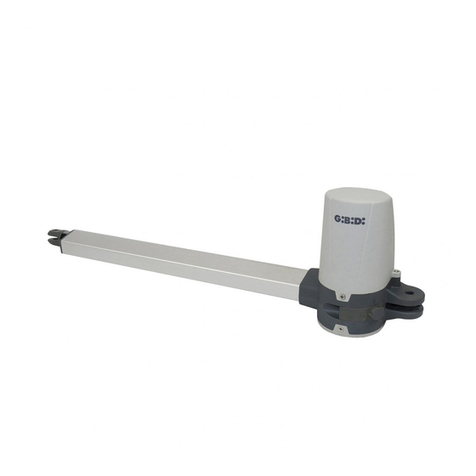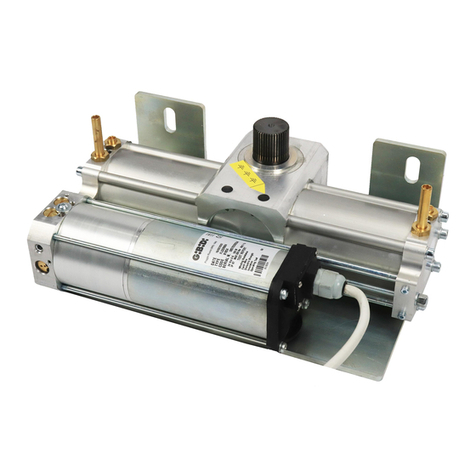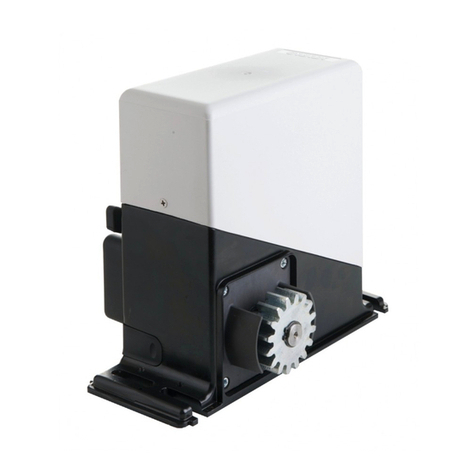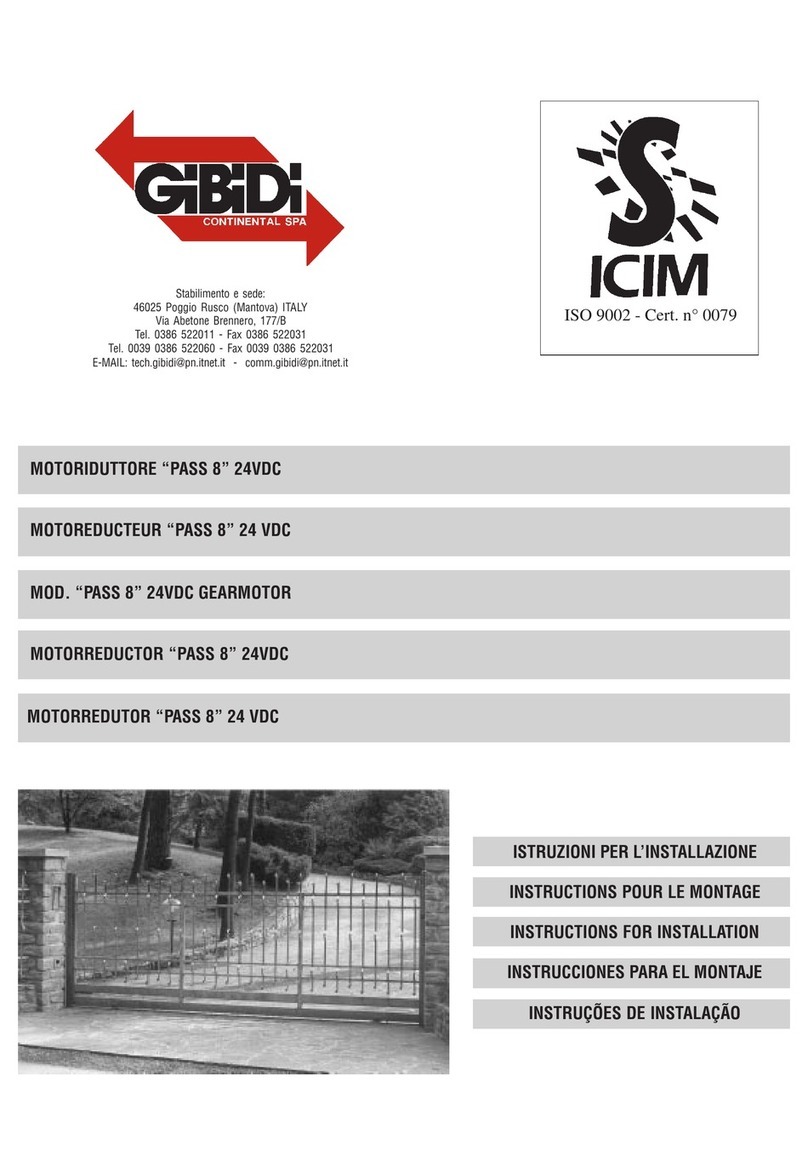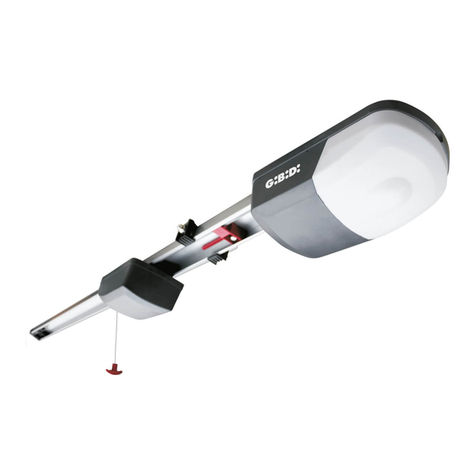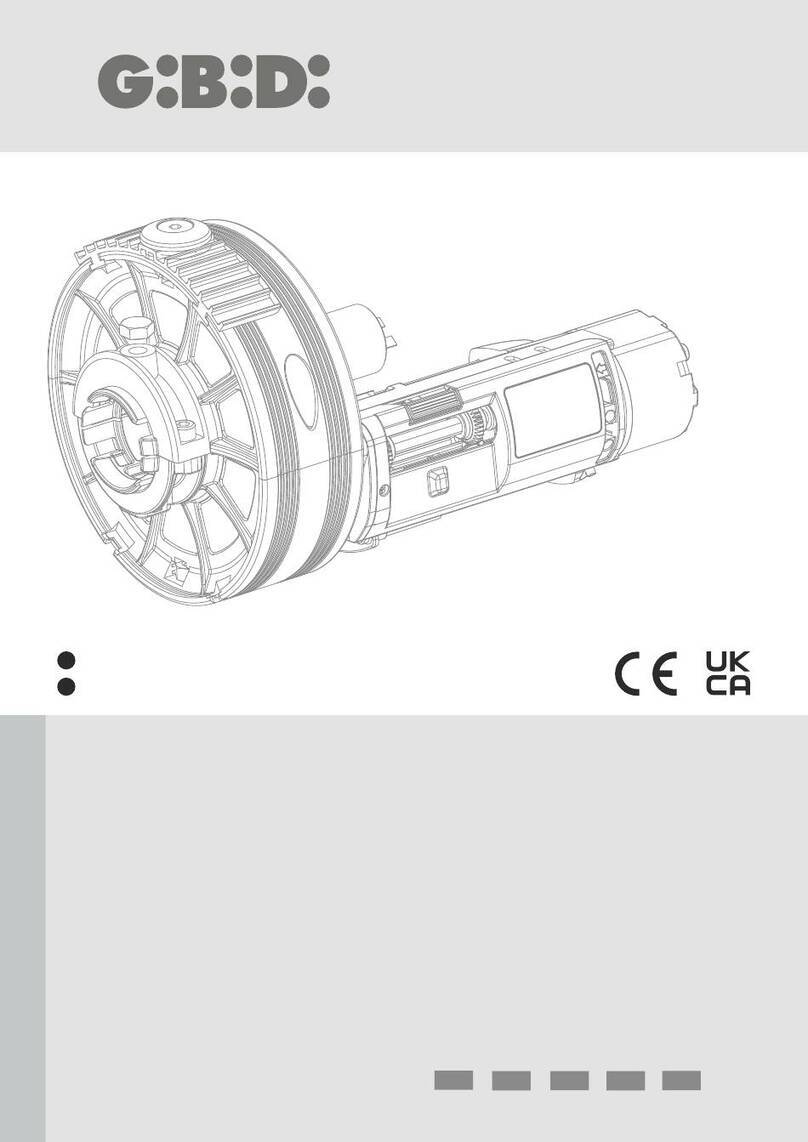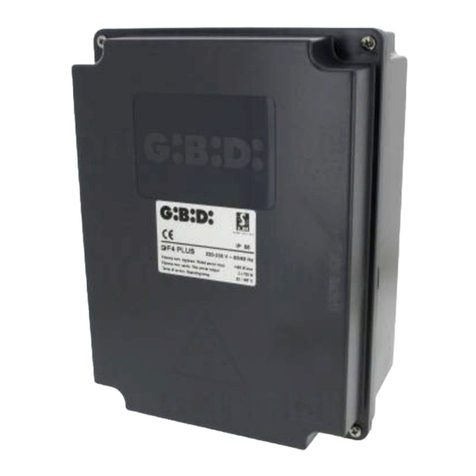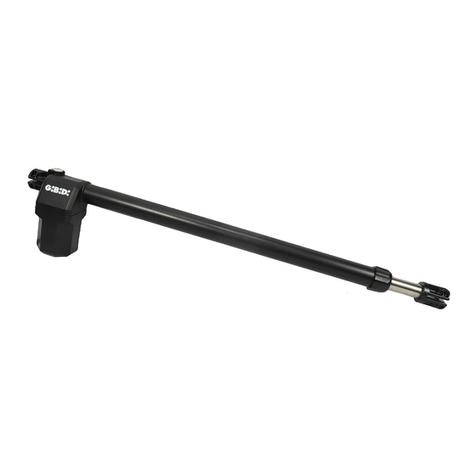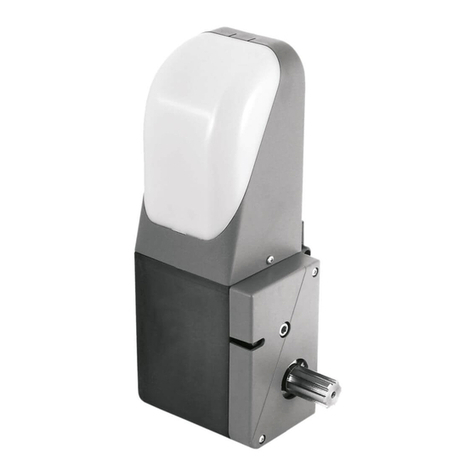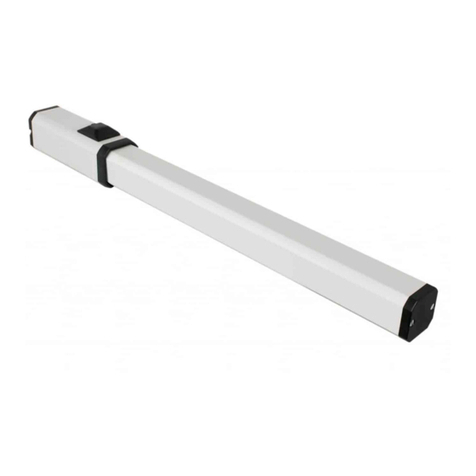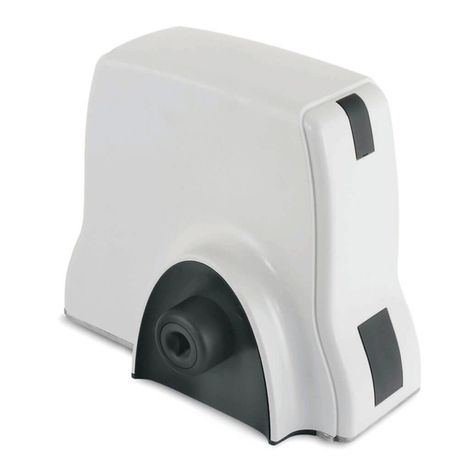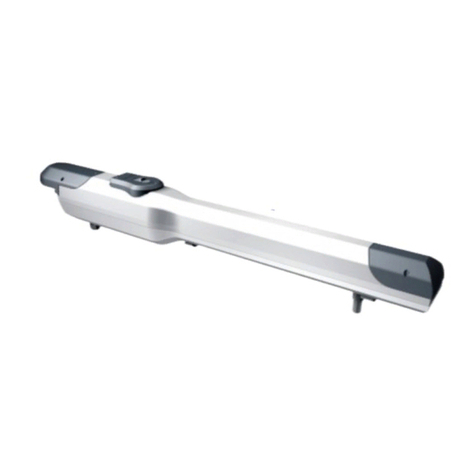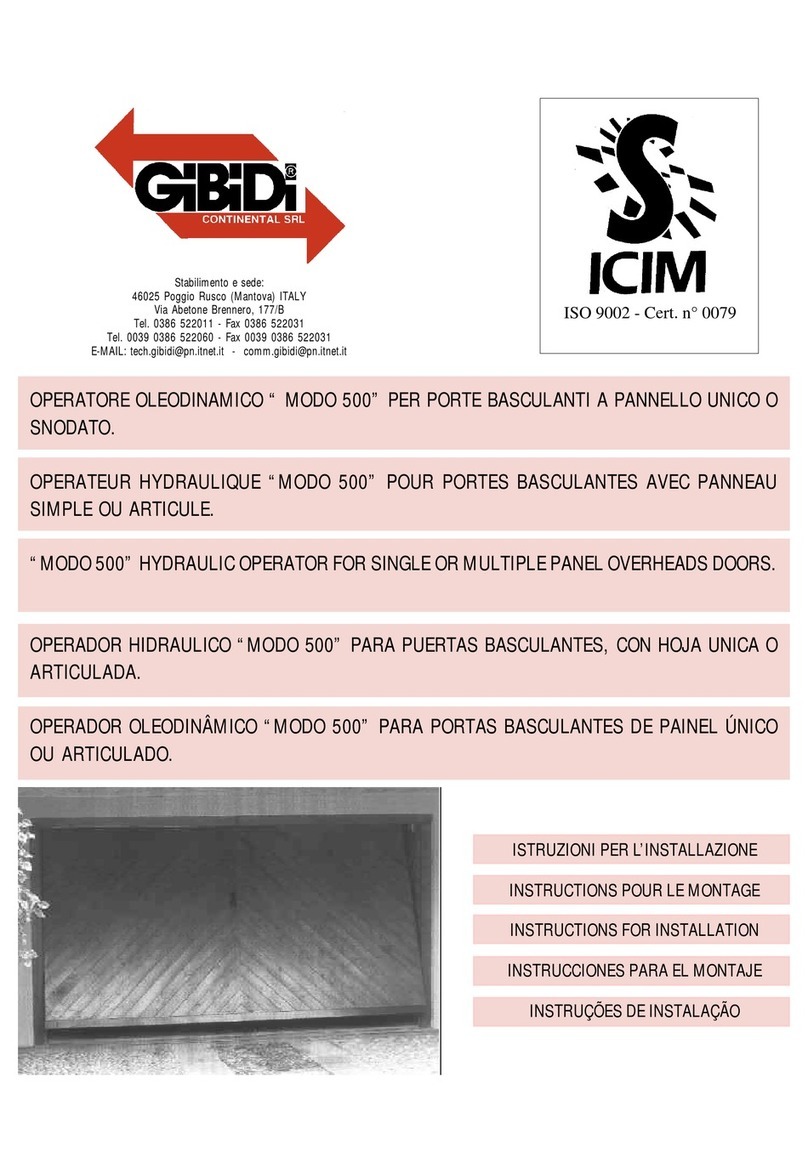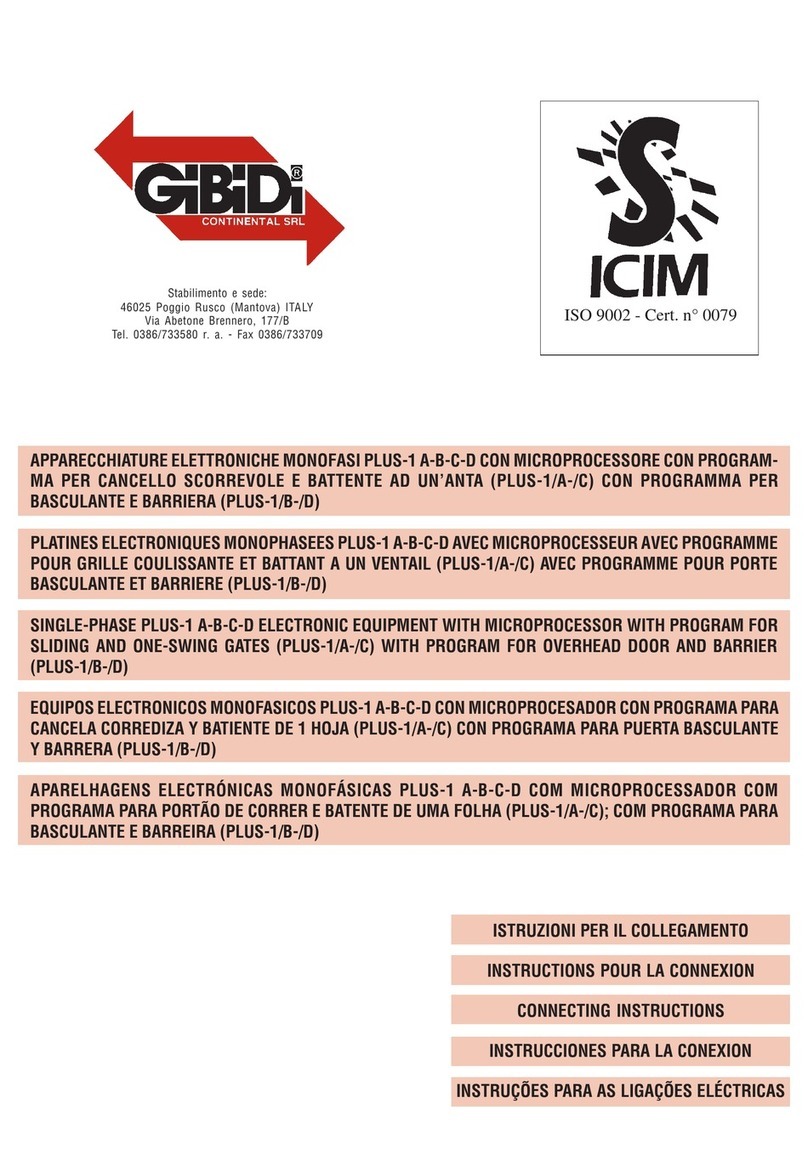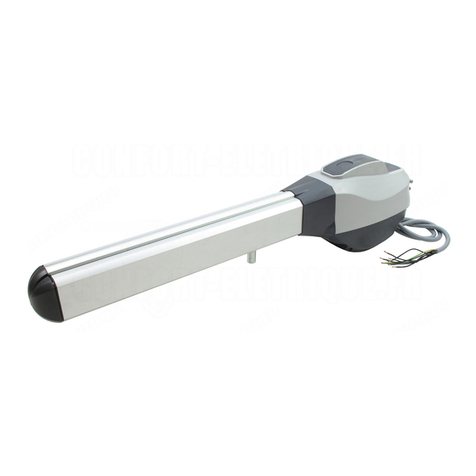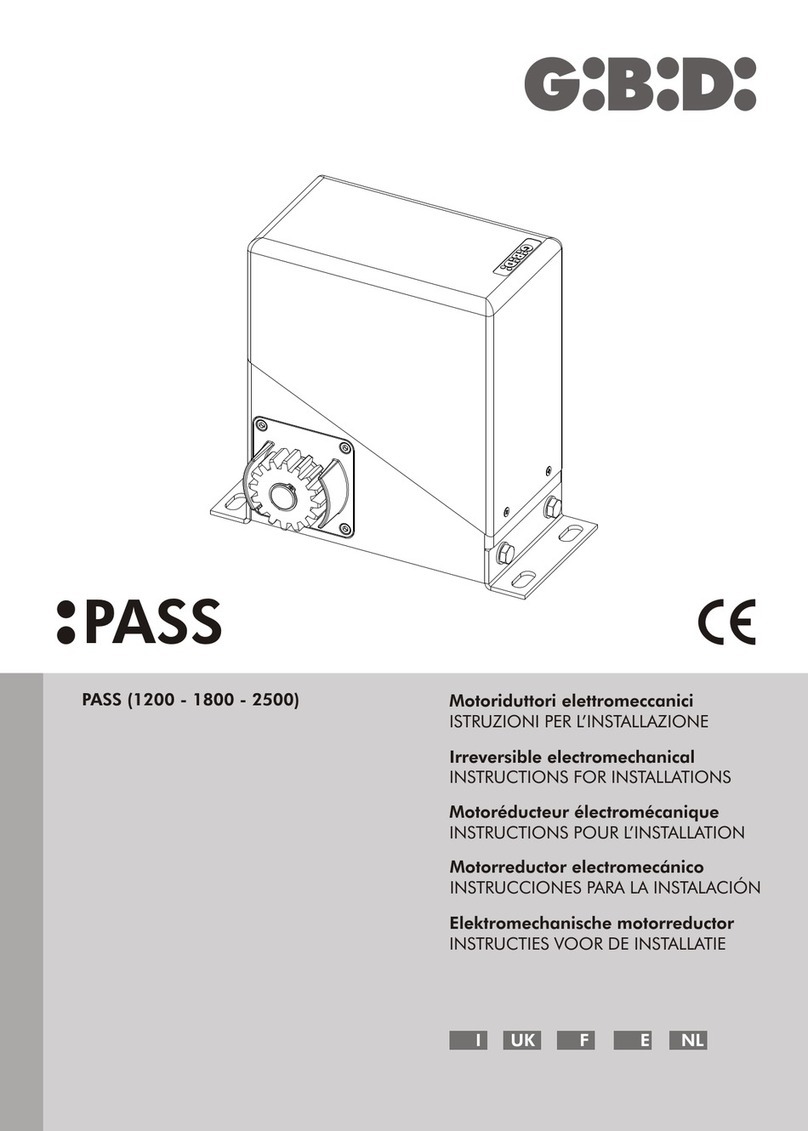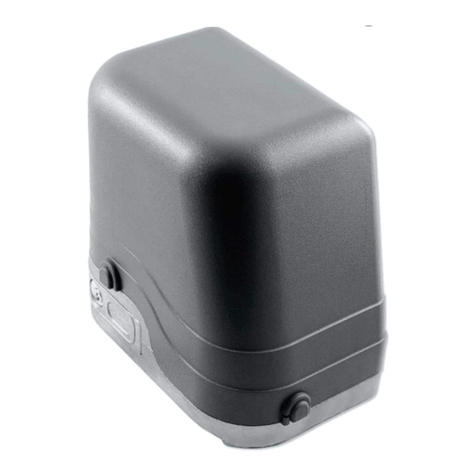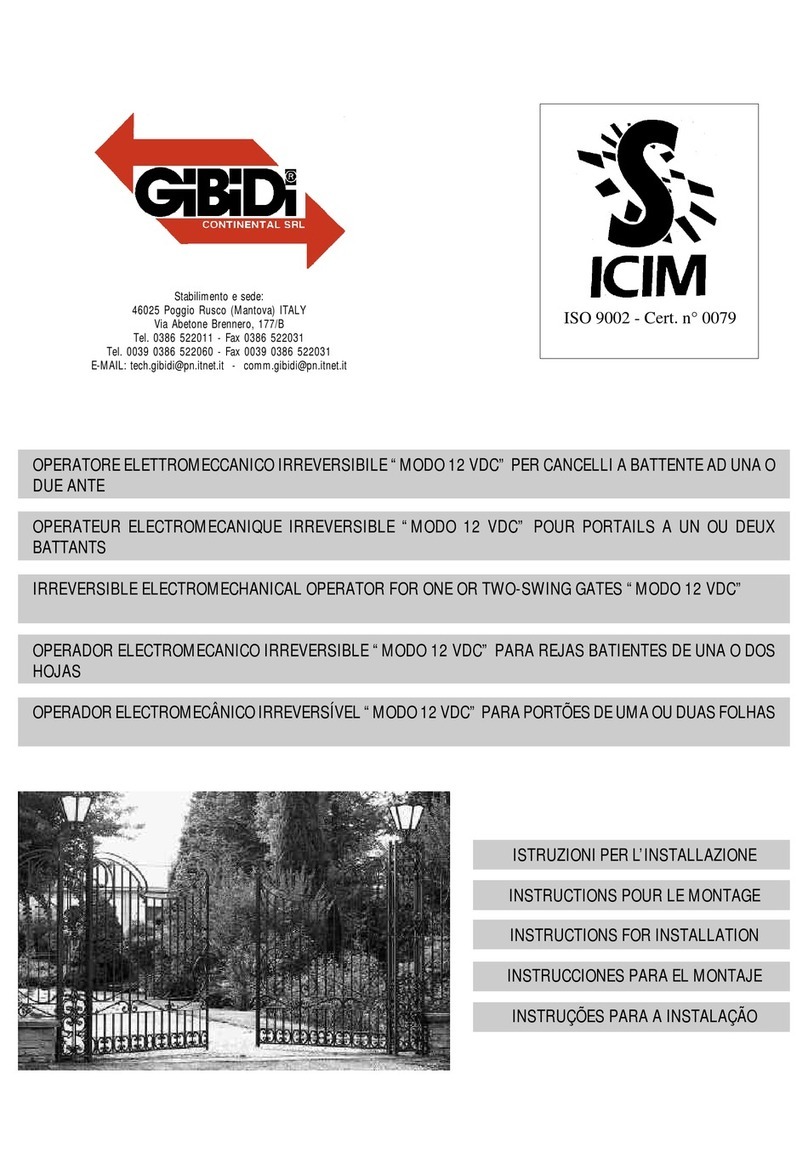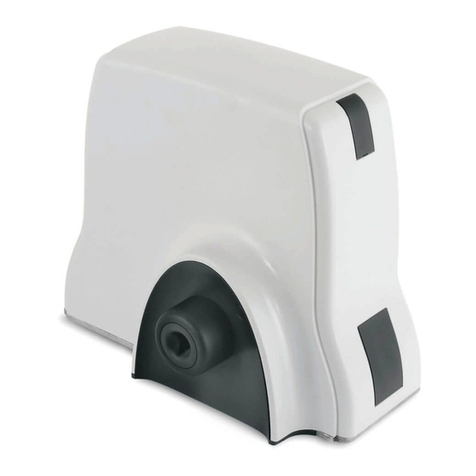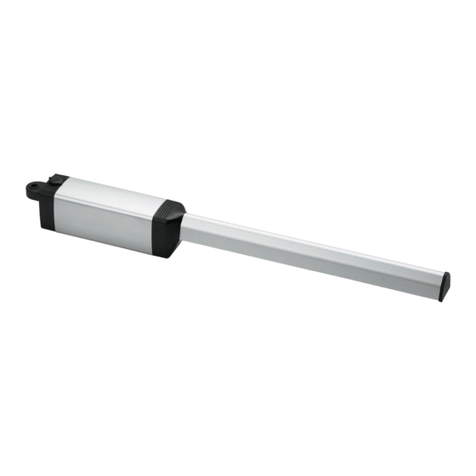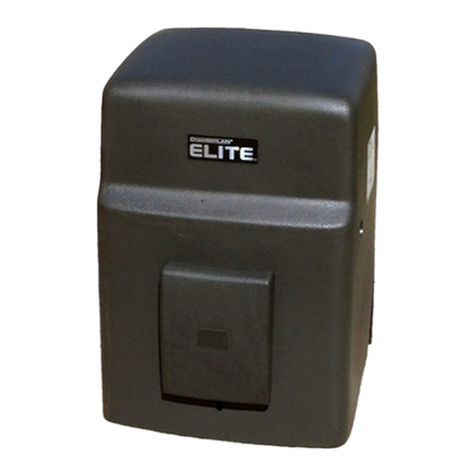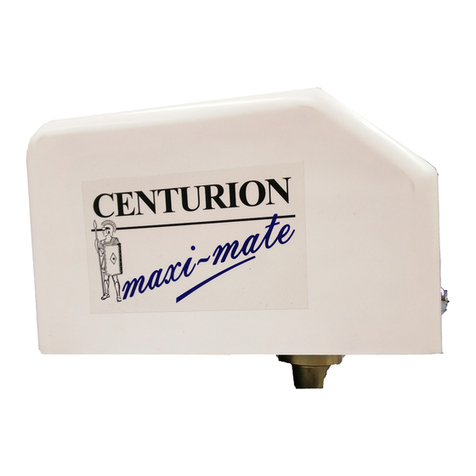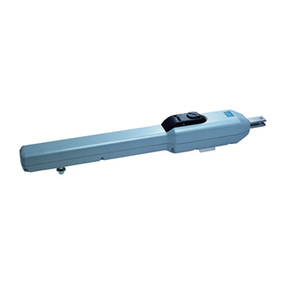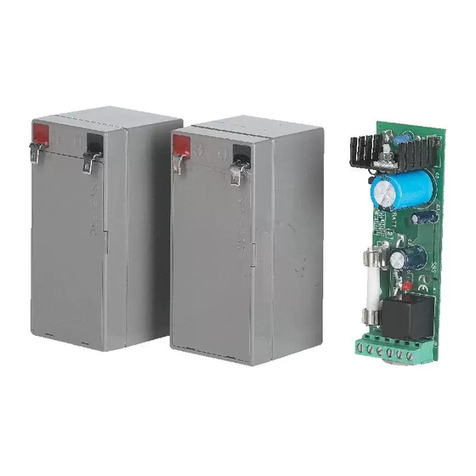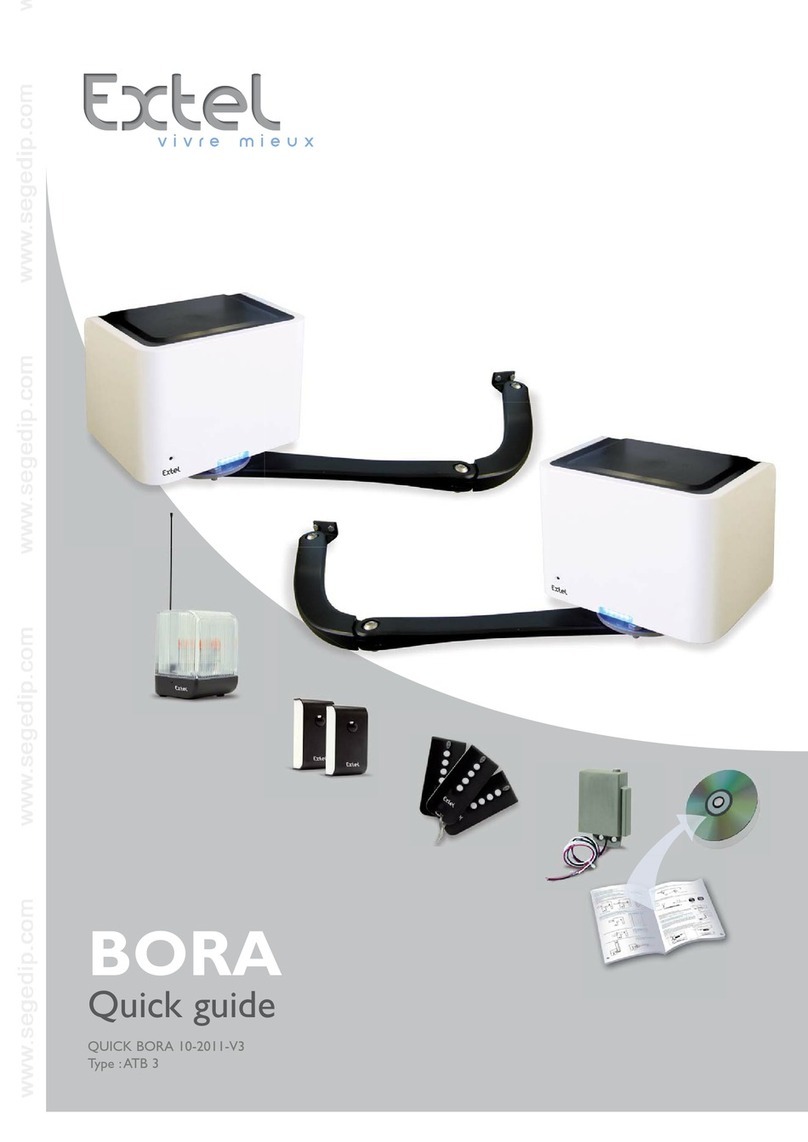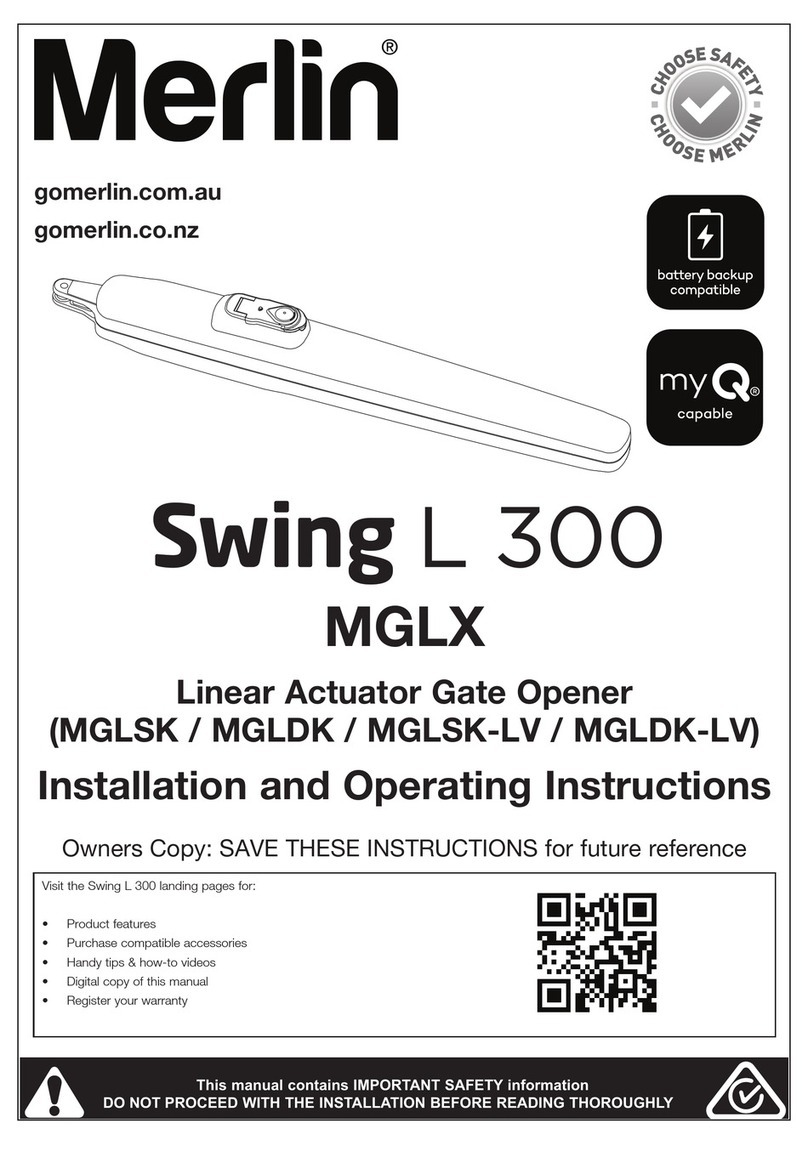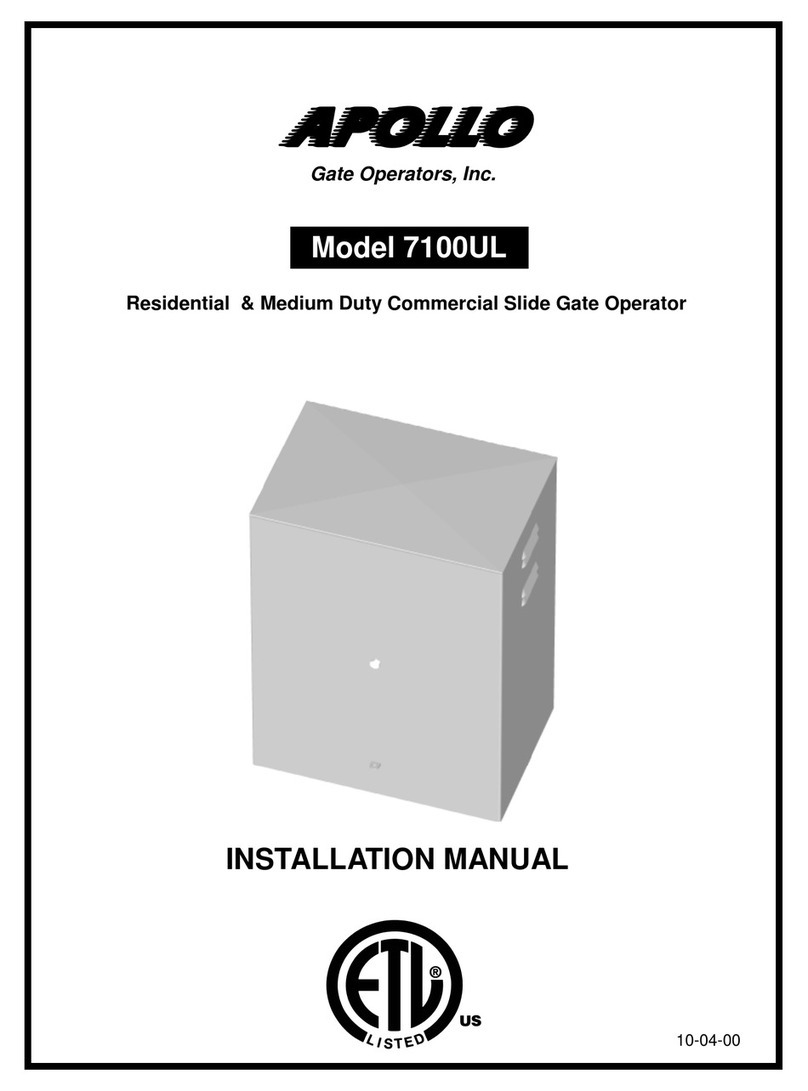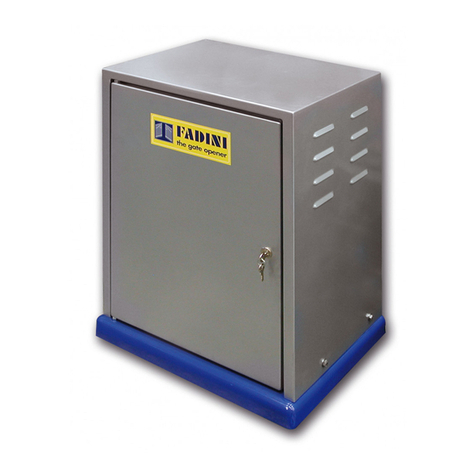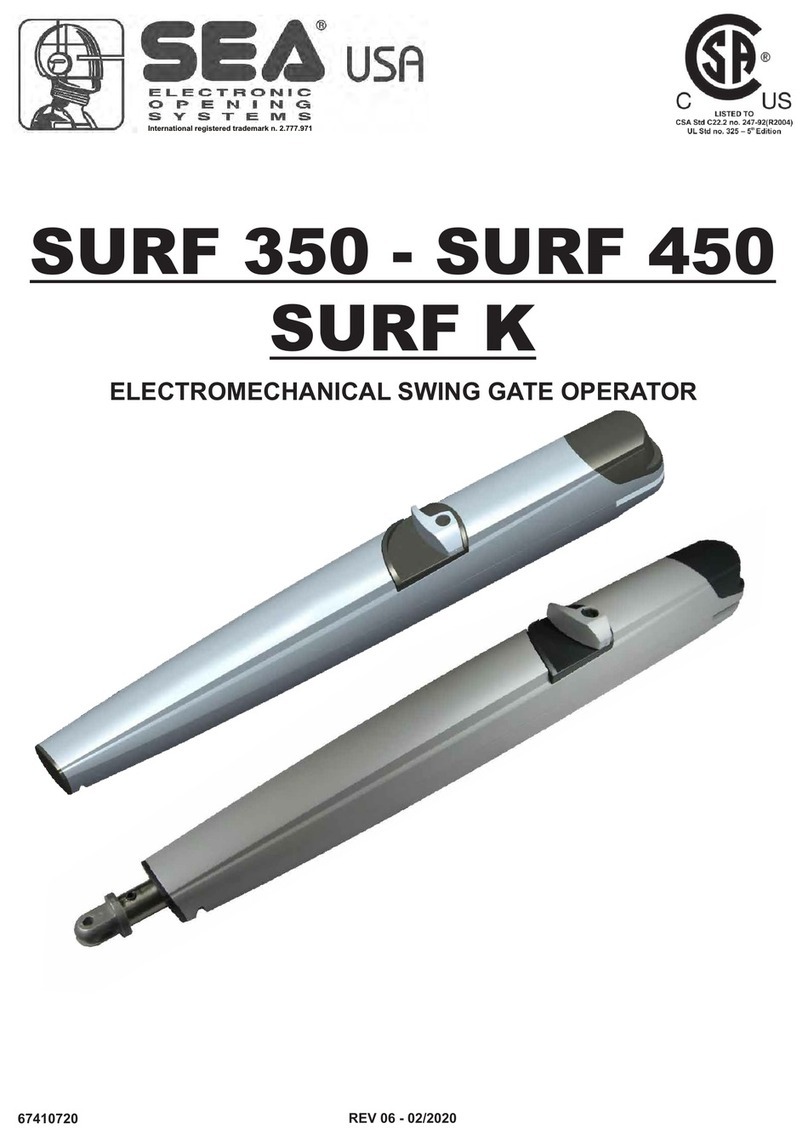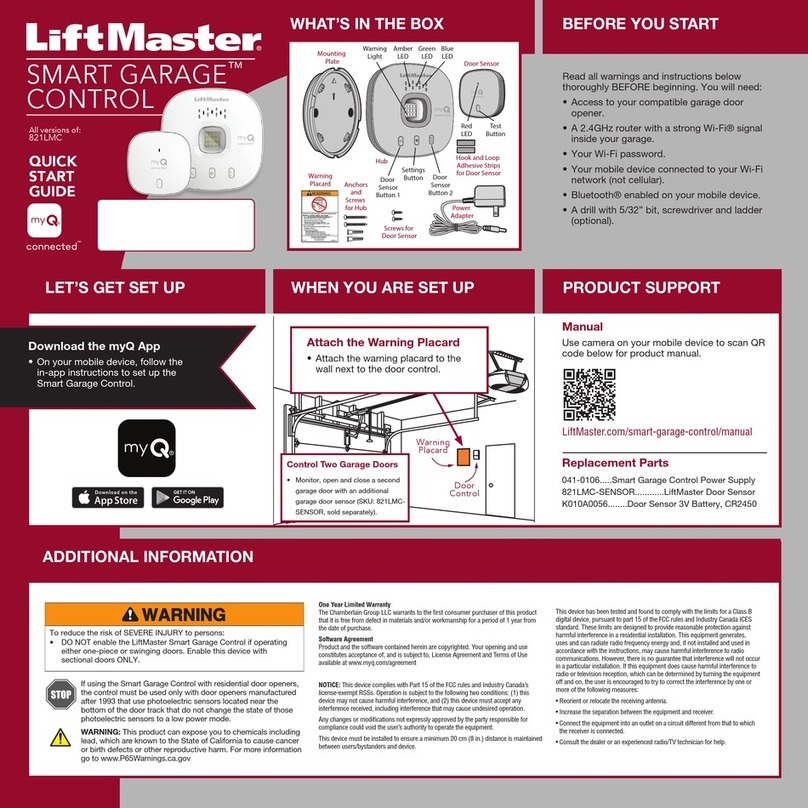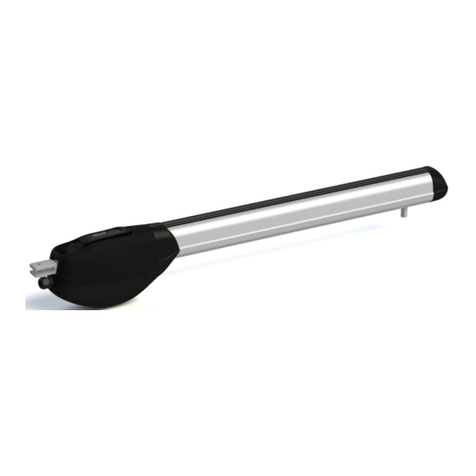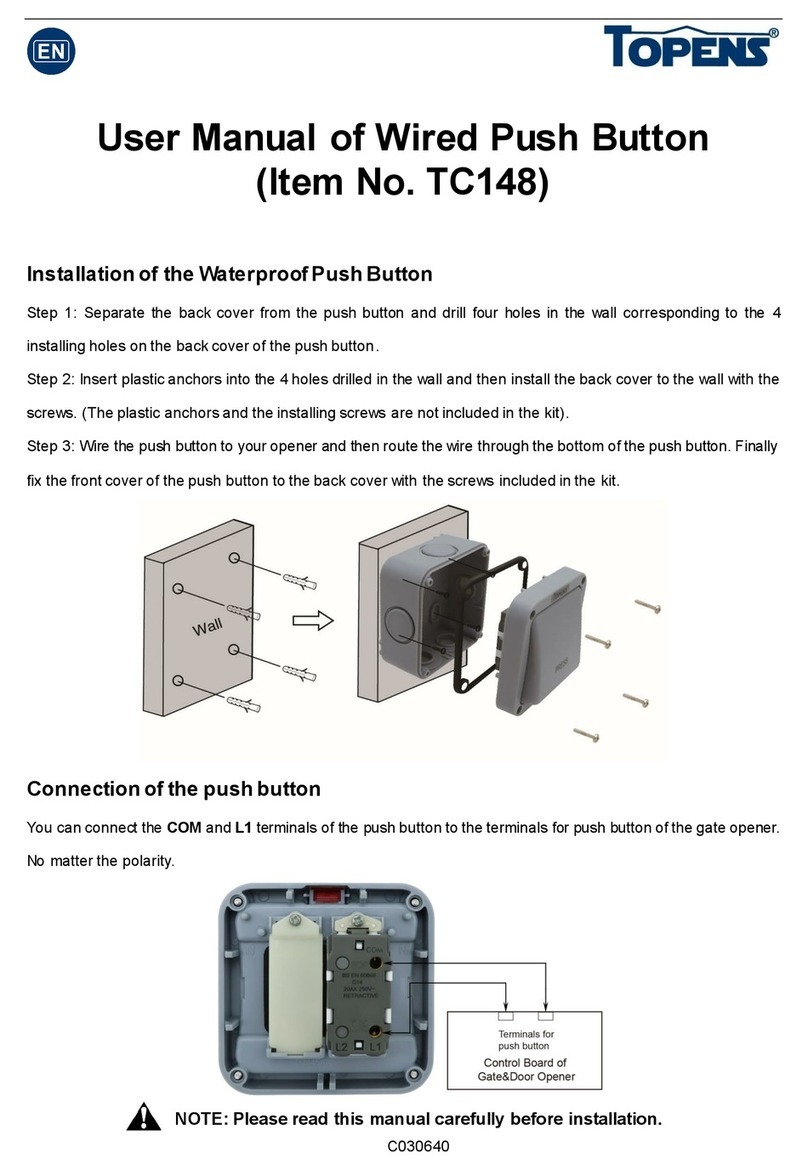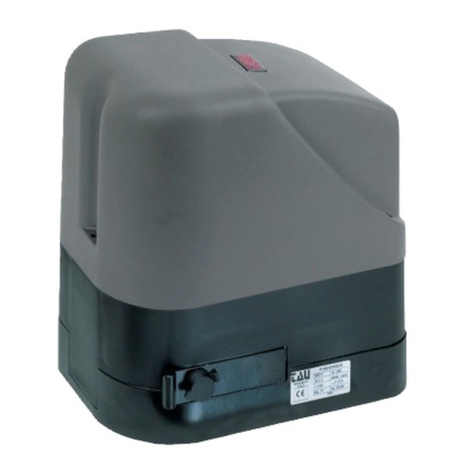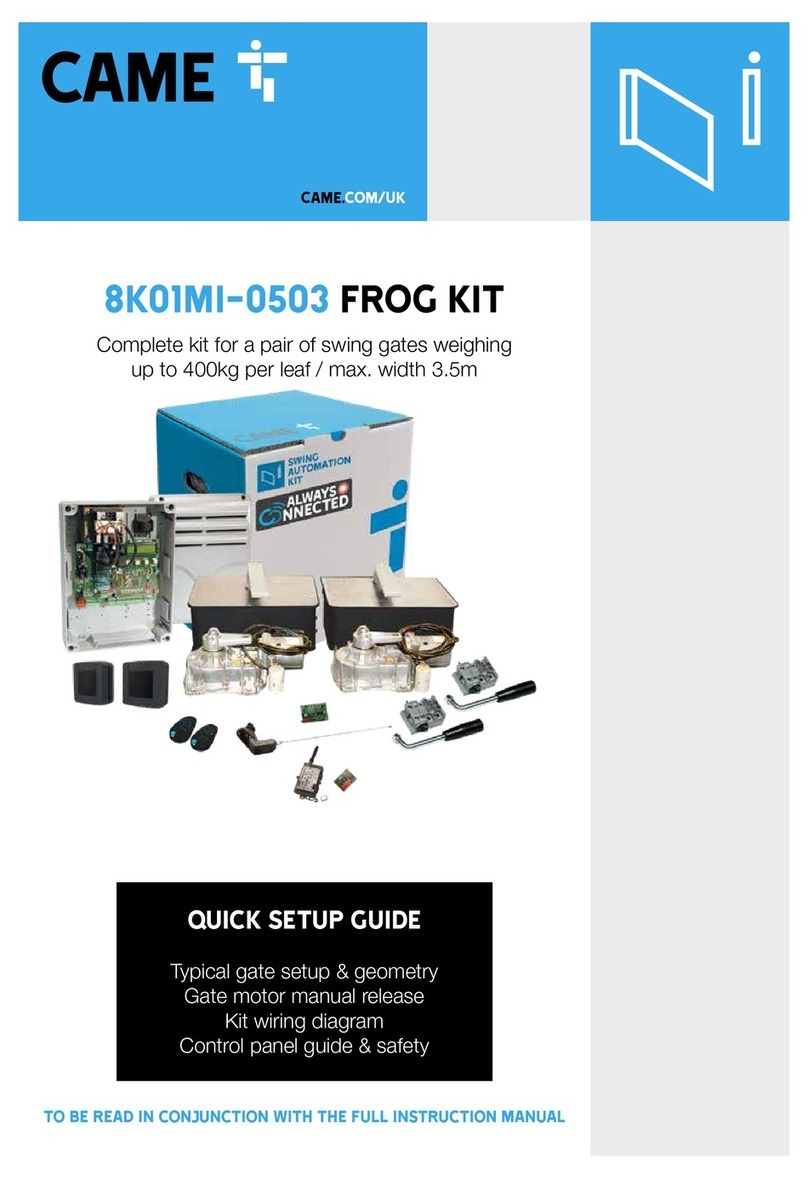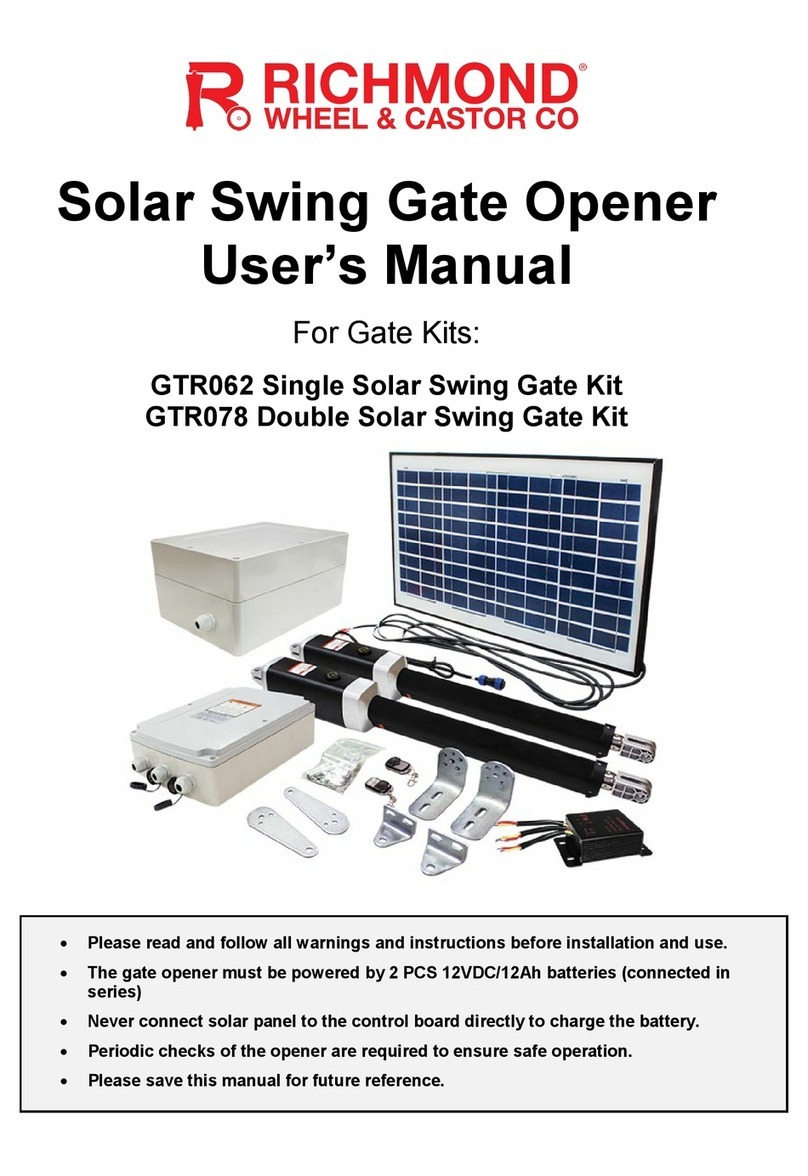GiBiDi SERRA321 Guide

IT UK
SERRA
FR ES NL
SERRA321 - (15841) Operatore elettromeccanico lineare
ISTRUZIONI PER L’INSTALLAZIONE
Electromechanical linear operator
INSTRUCTIONS FOR INSTALLATION
Opérateur électromécanique linéaire
INSTRUCTIONS POUR L’INSTALLATION
Operador electromecánico lineal
INSTRUCCIONES PARA LA INSTALACIÓN
Elektromechanische a
GEBRUIKSAANWIJZING VOOR DE INSTALLATIE
lineaire andrijving
DE PT GR
Linearer elektromechanischen Antrieb
MONTAGEANLEITUNG
Operador electromecânico linear
INSTRUÇÕES DE INSTALAÇÃO
Γραμμικό ηλεκτρομηχανικό μηχανισμό
ΟΔΗΓΙΕΣ ΕΓΚΑΤΑΣΤΑΣΗΣ

SERRA321
2
AVVERTENZE:Questo prodotto è stato collaudato in GI.BI.DI. verificando la perfetta corrispondenza delle caratteristiche alle
direttive vigenti. GI.BI.DI. S.r.l. si riserva la facoltà di modificare i dati tecnici senza avviso, in funzione dell’evoluzione del prodotto.
SMALTIMENTO: GI.BI.DI. consiglia di riciclare i componenti in plastica e di smaltire in appositi centri abilitati
i componenti elettronici evitando di contaminare l'ambiente con sostanze inquinanti.
IT
UK
WARNINGS:This product has been tested by GI.BI.DI. for full compliance with the requirements of the directives in force.
GI.BI.DI. S.r.l. reserves the right to change the technical data without prior notice in relation to product development.
DISPOSAL: GI.BI.DI. advises recycling the plastic components and to dispose of them at special authorised
centres for electronic components thus protecting the environment from polluting substances.
AVVERTISSEMENTS: Ce produit-ci a été essayé en GI.BI.DI. en vérifiant la parfaite correspondance des caractéristiques aux
directives en vigueur.
GI.BI.DI. S.r.l. se réserve la faculté de modifier les données techniques sans aviser, en fonction de l’évolution du produit.
ECOULEMENT: GI.BI.DI. conseille de recycler les composants en plastique d’écouler dans spéciaux centres
habilités les composants électroniques en évitant de contaminer le milieu avec substances polluantes.
FR
ES
ADVERTENCIAS: Este producto ha sido ensayado en GI.BI.DI. verificando la perfecta correspondencia de las características a las directivas
vigentes. GI.BI.DI. S.r.l. se reserva la facultad de modificar los datos técnicos sin aviso, en función de la evolución del producto.
ELIMINACIÓN: GI.BI.DI. aconseja reciclar los componentes en plástico y eliminar en adecuados centros
habilitados los componentes electrónicos, evitando contaminar el ambiente con substancias contaminantes.
NL
WAARSCHUWING: Dit product werd gekeurd bij GI.BI.DI. voor de naleving of de kenmerken van het product perfect
overeenkomen met de geldige richtlijnen. GI.BI.DI. behoudt zich het recht voor de technische gegevens te wijzigen zonder
waarschuwing vooraf, als dat nodig is voor evolutie van het product.
GI.BI.DI. adviseert om de kunstof componenten te recycleren en de elektronische componenten af te voeren
naar erkende inzamelpunten, om te voorkomen dat het milieu verontreinigd wordt door vervuilende stoffen.
LEES DEZE GEBRUIKSAANWIJZING HEEL AANDACHTIG ALVORENS DE INSTALLATIE AAN TE VATTEN.
LEER ATENTAMENTE ESTE MANUAL ANTES DE PROCEDER CON LA INSTALACIÓN.
LIRE ATTENTIVEMENT CETTE NOTICE AVANT DE PROCÉDER À L’INSTALLATION.
READ CAREFULLY THESE INSTRUCTIONS BEFORE PROCEEDING WITH INSTALLATION.
LEGGERE ATTENTAMENTE QUESTO MANUALE PRIMA DI PROCEDERE ALL’INSTALLAZIONE.
DE
WARNUNG Dieses Produkt wurde von GI.BI.DI. geprüft, wobei auf die perfekte Übereinstimmung der Eigenschaften mit den
geltenden Richtlinien geachtet wurde. Gi.Bi.Di. Srl. behält sich das Recht vor, die technischen Daten der Produkte ohne
Vorankündigung im Sinne der Weiterentwicklung und Verbesserung des Produkts zu ändern.
:
DIESE ANLEITUNG VOR DER MONTAGE AUFMERKSAM LESEN
ENTSORGUNG: Gi.Bi.Di empfiehlt, Kunststoffkomponenten dem Recycling zuzuführen und elektronische
Komponenten bei behördlich genehmigten Stellen zu entsorgen, um die Verschmutzung der Umwelt durch
Schadstoffe zu verhindern.
PT
ADVERTÊNCIAS:Este produto foi testado em Gi.Bi.Di. verificando a correspondência perfeita das características ao normas vigentes.
A Gi.Bi.Di. S.r.l. reserva-se o direito de modificar os dados técnicos sem pré-aviso em função de evolução do produto.
LER COM ATENÇÃO ESTE MANUAL ANTES DE PROCEDER COM A INSTALAÇÃO.
ELIMINAÇÃO: GI.BI.DI. Aconselha a reciclar as componentes em plástico e a eliminar as componentes
electrónicas em centros habilitados evitando desta forma poluir o ambiente com substâncias poluentes.
GR
ΣΗΜΕΙΩΣΗ: Η εταιρία GI.BI.DI. έχει ελέγξει αυτό το προιόν όσον αφορά την τέλεια προσαρμογή των χαρακτηριστικών του στην
ισχύουσα νομοθεσία. Η εταιρία GI.BI.DI. S.r.l. διατηρεί το δικαίωμα αλλαγών των τεχνικών προδιαγραφών χωρίς προϋγούμενη
ειδοποίηση και ανάλογα με την ανάπτυξη των προϊόντων της
ΠΑΡΑΚΑΛΟΥΜΕ ΝΑ ΔΙΑΒΑΣΤΕ ΠΡΟΣΕΚΤΙΚΑ ΑΥΤΕΣ ΤΙΣ ΟΔΗΓΙΕΣ ΠΡΙΝ ΤΗΝ ΕΓΚΑΤΑΣΤΑΣΗ
ΔΙΑΘΕΣΗ: Η GI.BI.DI. σας συμβουλεύει να ανακυκλώσετε τα πλαστικά εξαρτήματα και να διαθέσετε τα
ηλεκτρονικά εξαρτήματα μετά την απαξίωση τους, σε εξειδικεύμενα κέντρα που υπάρχουν για τον σκοπό
αυτό,συμβάλοντας έτσι στην προστασία του περιβάλλοντος απο τις παρενέργειες της μόλυνσης.
91b
1
2
3
4
5
MOT+
MOT-
+5V
S1/S2
COM
1
2
3
4
5
5
6
7
8
8
10
10
9
9
A
A
B
1a
SERRA321 3
D
C

SERRA321
2
AVVERTENZE:Questo prodotto è stato collaudato in GI.BI.DI. verificando la perfetta corrispondenza delle caratteristiche alle
direttive vigenti. GI.BI.DI. S.r.l. si riserva la facoltà di modificare i dati tecnici senza avviso, in funzione dell’evoluzione del prodotto.
SMALTIMENTO: GI.BI.DI. consiglia di riciclare i componenti in plastica e di smaltire in appositi centri abilitati
i componenti elettronici evitando di contaminare l'ambiente con sostanze inquinanti.
IT
UK
WARNINGS:This product has been tested by GI.BI.DI. for full compliance with the requirements of the directives in force.
GI.BI.DI. S.r.l. reserves the right to change the technical data without prior notice in relation to product development.
DISPOSAL: GI.BI.DI. advises recycling the plastic components and to dispose of them at special authorised
centres for electronic components thus protecting the environment from polluting substances.
AVVERTISSEMENTS: Ce produit-ci a été essayé en GI.BI.DI. en vérifiant la parfaite correspondance des caractéristiques aux
directives en vigueur.
GI.BI.DI. S.r.l. se réserve la faculté de modifier les données techniques sans aviser, en fonction de l’évolution du produit.
ECOULEMENT: GI.BI.DI. conseille de recycler les composants en plastique d’écouler dans spéciaux centres
habilités les composants électroniques en évitant de contaminer le milieu avec substances polluantes.
FR
ES
ADVERTENCIAS: Este producto ha sido ensayado en GI.BI.DI. verificando la perfecta correspondencia de las características a las directivas
vigentes. GI.BI.DI. S.r.l. se reserva la facultad de modificar los datos técnicos sin aviso, en función de la evolución del producto.
ELIMINACIÓN: GI.BI.DI. aconseja reciclar los componentes en plástico y eliminar en adecuados centros
habilitados los componentes electrónicos, evitando contaminar el ambiente con substancias contaminantes.
NL
WAARSCHUWING: Dit product werd gekeurd bij GI.BI.DI. voor de naleving of de kenmerken van het product perfect
overeenkomen met de geldige richtlijnen. GI.BI.DI. behoudt zich het recht voor de technische gegevens te wijzigen zonder
waarschuwing vooraf, als dat nodig is voor evolutie van het product.
GI.BI.DI. adviseert om de kunstof componenten te recycleren en de elektronische componenten af te voeren
naar erkende inzamelpunten, om te voorkomen dat het milieu verontreinigd wordt door vervuilende stoffen.
LEES DEZE GEBRUIKSAANWIJZING HEEL AANDACHTIG ALVORENS DE INSTALLATIE AAN TE VATTEN.
LEER ATENTAMENTE ESTE MANUAL ANTES DE PROCEDER CON LA INSTALACIÓN.
LIRE ATTENTIVEMENT CETTE NOTICE AVANT DE PROCÉDER À L’INSTALLATION.
READ CAREFULLY THESE INSTRUCTIONS BEFORE PROCEEDING WITH INSTALLATION.
LEGGERE ATTENTAMENTE QUESTO MANUALE PRIMA DI PROCEDERE ALL’INSTALLAZIONE.
DE
WARNUNG Dieses Produkt wurde von GI.BI.DI. geprüft, wobei auf die perfekte Übereinstimmung der Eigenschaften mit den
geltenden Richtlinien geachtet wurde. Gi.Bi.Di. Srl. behält sich das Recht vor, die technischen Daten der Produkte ohne
Vorankündigung im Sinne der Weiterentwicklung und Verbesserung des Produkts zu ändern.
:
DIESE ANLEITUNG VOR DER MONTAGE AUFMERKSAM LESEN
ENTSORGUNG: Gi.Bi.Di empfiehlt, Kunststoffkomponenten dem Recycling zuzuführen und elektronische
Komponenten bei behördlich genehmigten Stellen zu entsorgen, um die Verschmutzung der Umwelt durch
Schadstoffe zu verhindern.
PT
ADVERTÊNCIAS:Este produto foi testado em Gi.Bi.Di. verificando a correspondência perfeita das características ao normas vigentes.
A Gi.Bi.Di. S.r.l. reserva-se o direito de modificar os dados técnicos sem pré-aviso em função de evolução do produto.
LER COM ATENÇÃO ESTE MANUAL ANTES DE PROCEDER COM A INSTALAÇÃO.
ELIMINAÇÃO: GI.BI.DI. Aconselha a reciclar as componentes em plástico e a eliminar as componentes
electrónicas em centros habilitados evitando desta forma poluir o ambiente com substâncias poluentes.
GR
ΣΗΜΕΙΩΣΗ: Η εταιρία GI.BI.DI. έχει ελέγξει αυτό το προιόν όσον αφορά την τέλεια προσαρμογή των χαρακτηριστικών του στην
ισχύουσα νομοθεσία. Η εταιρία GI.BI.DI. S.r.l. διατηρεί το δικαίωμα αλλαγών των τεχνικών προδιαγραφών χωρίς προϋγούμενη
ειδοποίηση και ανάλογα με την ανάπτυξη των προϊόντων της
ΠΑΡΑΚΑΛΟΥΜΕ ΝΑ ΔΙΑΒΑΣΤΕ ΠΡΟΣΕΚΤΙΚΑ ΑΥΤΕΣ ΤΙΣ ΟΔΗΓΙΕΣ ΠΡΙΝ ΤΗΝ ΕΓΚΑΤΑΣΤΑΣΗ
ΔΙΑΘΕΣΗ: Η GI.BI.DI. σας συμβουλεύει να ανακυκλώσετε τα πλαστικά εξαρτήματα και να διαθέσετε τα
ηλεκτρονικά εξαρτήματα μετά την απαξίωση τους, σε εξειδικεύμενα κέντρα που υπάρχουν για τον σκοπό
αυτό,συμβάλοντας έτσι στην προστασία του περιβάλλοντος απο τις παρενέργειες της μόλυνσης.
91b
1
2
3
4
5
MOT+
MOT-
+5V
S1/S2
COM
1
2
3
4
5
5
6
7
8
8
10
10
9
9
A
A
B
1a
SERRA321 3
D
C

93
2
Cu
C
A
d1
β
D ≥ 90
B > 60+d1 per/for β = 90°
a1 > 60
B ≥ 140 per/for β = 110°
85 78
897 mm
109 mm
755 mm
151 mm
SERRA321
4
8 9
6 7
100/120
B
A
100/120
150150
B
A
4 5
SERRA321 5

93
2
Cu
C
A
d1
β
D ≥ 90
B > 60+d1 per/for β = 90°
a1 > 60
B ≥ 140 per/for β = 110°
85 78
897 mm
109 mm
755 mm
151 mm
SERRA321
4
8 9
6 7
100/120
B
A
100/120
150150
B
A
4 5
SERRA321 5

10 11
12 16
17 18
SERRA321
6
20
21
3
4
5
6
4
3
6
5
3
4
7
2
1
5
1
2
7
SERRA321 7

10 11
12 16
17 18
SERRA321
6
20
21
3
4
5
6
4
3
6
5
3
4
7
2
1
5
1
2
7
SERRA321 7

SERRA321
IT
ATTENZIONE: IMPORTANTI ISTRUZIONI DI SICUREZZA.
E' importante per la sicurezza delle persone seguire queste istruzioni.
Conservare il presente libretto di istruzioni.
8
• In caso di guasto o anomalie di funzionamento staccare l'alimentazione a monte dell'apparecchiatura e chiamare
l'assistenza tecnica.
• Verificare periodicamente il funzionamento delle sicurezze. Le eventuali riparazioni devono essere eseguite da
personale specializzato usando materiali originali e certificati.
• Il prodotto non deve essere usato da bambini o persone con ridotte capacità fisiche, sensoriali o mentali, oppure
mancanti di esperienza e conoscenza, a meno che non siano stati correttamente istruiti.
• Non accedere alla scheda per regolazioni e/o manutenzioni.
AVVERTENZE PER L'UTENTE
ATTENZIONE: è importante che sulla linea di alimentazione venga installato, a monte
dell'apparecchiatura, un interruttore magnetotermico onnipolare con apertura minima dei
contatti pari a 3 mm.
Predisposizione impianto elettrico
Predisporre l'impianto elettrico come indicato (1a - 1b) facendo riferimento alle norme vigenti per gli impianti elettrici
ed altre norme nazionali. Tenere nettamente separati i collegamenti di alimentazione di rete dai collegamenti
di servizio (fotocellule, coste sensibili, dispositivi di comando ecc.).
I componenti principali sono:
1 - Antenna; cavo coassiale schermato
2 - Contenitore apparecchiatura elettronica
3 - Elettroserratura; cavo a 2 conduttori da 1mm² (2x1)
4 - Selettore a chiave; cavo a 3 conduttori da 0,5 mm² (3x0,5)
5 - Operatori 24Vcc:
• alimentazione cavo a 2 conduttori da 1,5 mm² (2x1,5)
per una lunghezza cavo massimo 6 m, oltre è necessario aumentare la sezione del cavo
• cavi encoder 3 conduttori da 0,5 mm² (3x0,5):
6 - Interruttore magnetotermico onnipolare con apertura minima dei contatti pari a 3 mm
Linea di alimentazione all'apparecchiatura 220-230V 50-60Hz; cavo a 3 conduttori da 1,5 mm² min. (3x1,5)
(Attenersi alle norme vigenti)
7 - Segnalatore a luce lampeggiante a 24V; cavo a 2 conduttori da 0,75 mm² (2x0,75)
8 - Scatole di derivazione
9 - Trasmettitore fotocellula; cavo a 2 conduttori da 0,5 mm² (2x0,5)
10 - Ricevitore fotocellula; cavo a 4 conduttori a 0,5 mm² (4x0,5)
per una lunghezza cavo massimo 6 m, oltre è necessario aumentare la sezione del cavo
PREDISPOSIZIONI ELETTRICHE
SERRA321
IT
9
L'operatore SERRA321 per cancelli ad ante battenti è un operatore elettromeccanico che trasmette il movimento
all'anta tramite un sistema a vite senza fine. Prevede il blocco quando il motore non è in funzione, non è necessario
pertanto installare serrature per ante fino a 2 mt.
• Prima di procedere con l'installazione bisogna predisporre a monte dell'impianto un interruttore magneto termico
o differenziale con portata massima 10A. L'interruttore deve garantire una separazione omnipolare dei contatti,
con distanza di apertura di almeno 3mm.
• Tutti i materiali presenti nell'imballo non devono essere lasciati alla portata dei bambini in quanto potenziali fonti
di pericolo.
• Il costruttore declina ogni responsabilità ai fini del corretto funzionamento dell'automazione nel caso non vengano
utilizzati i componenti e gli accessori di propria produzione e idonei per l'applicazione prevista.
• Al termine dell'installazione verificare sempre con attenzione il corretto funzionamento dell'impianto e dei
dispositivi utilizzati.
• Questo manuale d'istruzione si rivolge a persone abilitate all'installazione di “apparecchi sotto tensione”,
pertanto si richiede una buona conoscenza della tecnica, esercitata come professione e nel rispetto delle
norme vigenti.
• La manutenzione deve essere eseguita da personale qualificato.
• Prima di eseguire qualsiasi operazione di pulizia o di manutenzione, scollegare l'apparecchiatura dalle rete di
alimentazione elettrica.
• Questo prodotto e stato progettato e costruito esclusivamente per I'utilizzo indicato in questa documentazione.
Usi non indicati in questa documentazione potrebbero essere fonte di danni al prodotto e fonte di pericolo.
• Verificare lo scopo dell'utilizzo finale e assicurarsi di prendere tutte le sicurezze necessarie.
• L'utilizzo dei prodotti e la loro destinazione ad usi diversi da quelli previsti, non è stata sperimentata dal costruttore,
pertanto i lavori eseguiti sono sotto la completa responsabilità dell'installatore.
• Segnalare l'automazione con targhe di avvertenza che devono essere visibili.
• Avvisare l'utente che i bambini o animali non devono giocare o sostare nei pressi del cancello.
• Proteggere adeguatamente i punti di pericolo per esempio mediante l'uso di una costa sensibile).
• Verificare se I 'impianto di terra è realizzato correttamente: collegare tutte le parti metalliche della chiusura (porte,
cancelli, ecc.) e tutti i componenti dell'impianto provvisti di morsetto di terra.
• Usare esclusivamente parti originali per qualsiasi manutenzione o riparazione.
• Non eseguire alcuna modifica ai componenti dell'automazione se non espressamente autorizzata dalla Ditta.
Utilizzare pressacavi adeguati ad assicurare la corretta connessione meccanica del cablaggio e tali da mantenere
il grado di protezione IP 44.
PREMESSA
AVVERTENZE PER L'INSTALLAZIONE

SERRA321
IT
ATTENZIONE: IMPORTANTI ISTRUZIONI DI SICUREZZA.
E' importante per la sicurezza delle persone seguire queste istruzioni.
Conservare il presente libretto di istruzioni.
8
• In caso di guasto o anomalie di funzionamento staccare l'alimentazione a monte dell'apparecchiatura e chiamare
l'assistenza tecnica.
• Verificare periodicamente il funzionamento delle sicurezze. Le eventuali riparazioni devono essere eseguite da
personale specializzato usando materiali originali e certificati.
• Il prodotto non deve essere usato da bambini o persone con ridotte capacità fisiche, sensoriali o mentali, oppure
mancanti di esperienza e conoscenza, a meno che non siano stati correttamente istruiti.
• Non accedere alla scheda per regolazioni e/o manutenzioni.
AVVERTENZE PER L'UTENTE
ATTENZIONE: è importante che sulla linea di alimentazione venga installato, a monte
dell'apparecchiatura, un interruttore magnetotermico onnipolare con apertura minima dei
contatti pari a 3 mm.
Predisposizione impianto elettrico
Predisporre l'impianto elettrico come indicato (1a - 1b) facendo riferimento alle norme vigenti per gli impianti elettrici
ed altre norme nazionali. Tenere nettamente separati i collegamenti di alimentazione di rete dai collegamenti
di servizio (fotocellule, coste sensibili, dispositivi di comando ecc.).
I componenti principali sono:
1 - Antenna; cavo coassiale schermato
2 - Contenitore apparecchiatura elettronica
3 - Elettroserratura; cavo a 2 conduttori da 1mm² (2x1)
4 - Selettore a chiave; cavo a 3 conduttori da 0,5 mm² (3x0,5)
5 - Operatori 24Vcc:
• alimentazione cavo a 2 conduttori da 1,5 mm² (2x1,5)
per una lunghezza cavo massimo 6 m, oltre è necessario aumentare la sezione del cavo
• cavi encoder 3 conduttori da 0,5 mm² (3x0,5):
6 - Interruttore magnetotermico onnipolare con apertura minima dei contatti pari a 3 mm
Linea di alimentazione all'apparecchiatura 220-230V 50-60Hz; cavo a 3 conduttori da 1,5 mm² min. (3x1,5)
(Attenersi alle norme vigenti)
7 - Segnalatore a luce lampeggiante a 24V; cavo a 2 conduttori da 0,75 mm² (2x0,75)
8 - Scatole di derivazione
9 - Trasmettitore fotocellula; cavo a 2 conduttori da 0,5 mm² (2x0,5)
10 - Ricevitore fotocellula; cavo a 4 conduttori a 0,5 mm² (4x0,5)
per una lunghezza cavo massimo 6 m, oltre è necessario aumentare la sezione del cavo
PREDISPOSIZIONI ELETTRICHE
SERRA321
IT
9
L'operatore SERRA321 per cancelli ad ante battenti è un operatore elettromeccanico che trasmette il movimento
all'anta tramite un sistema a vite senza fine. Prevede il blocco quando il motore non è in funzione, non è necessario
pertanto installare serrature per ante fino a 2 mt.
• Prima di procedere con l'installazione bisogna predisporre a monte dell'impianto un interruttore magneto termico
o differenziale con portata massima 10A. L'interruttore deve garantire una separazione omnipolare dei contatti,
con distanza di apertura di almeno 3mm.
• Tutti i materiali presenti nell'imballo non devono essere lasciati alla portata dei bambini in quanto potenziali fonti
di pericolo.
• Il costruttore declina ogni responsabilità ai fini del corretto funzionamento dell'automazione nel caso non vengano
utilizzati i componenti e gli accessori di propria produzione e idonei per l'applicazione prevista.
• Al termine dell'installazione verificare sempre con attenzione il corretto funzionamento dell'impianto e dei
dispositivi utilizzati.
• Questo manuale d'istruzione si rivolge a persone abilitate all'installazione di “apparecchi sotto tensione”,
pertanto si richiede una buona conoscenza della tecnica, esercitata come professione e nel rispetto delle
norme vigenti.
• La manutenzione deve essere eseguita da personale qualificato.
• Prima di eseguire qualsiasi operazione di pulizia o di manutenzione, scollegare l'apparecchiatura dalle rete di
alimentazione elettrica.
• Questo prodotto e stato progettato e costruito esclusivamente per I'utilizzo indicato in questa documentazione.
Usi non indicati in questa documentazione potrebbero essere fonte di danni al prodotto e fonte di pericolo.
• Verificare lo scopo dell'utilizzo finale e assicurarsi di prendere tutte le sicurezze necessarie.
• L'utilizzo dei prodotti e la loro destinazione ad usi diversi da quelli previsti, non è stata sperimentata dal costruttore,
pertanto i lavori eseguiti sono sotto la completa responsabilità dell'installatore.
• Segnalare l'automazione con targhe di avvertenza che devono essere visibili.
• Avvisare l'utente che i bambini o animali non devono giocare o sostare nei pressi del cancello.
• Proteggere adeguatamente i punti di pericolo per esempio mediante l'uso di una costa sensibile).
• Verificare se I 'impianto di terra è realizzato correttamente: collegare tutte le parti metalliche della chiusura (porte,
cancelli, ecc.) e tutti i componenti dell'impianto provvisti di morsetto di terra.
• Usare esclusivamente parti originali per qualsiasi manutenzione o riparazione.
• Non eseguire alcuna modifica ai componenti dell'automazione se non espressamente autorizzata dalla Ditta.
Utilizzare pressacavi adeguati ad assicurare la corretta connessione meccanica del cablaggio e tali da mantenere
il grado di protezione IP 44.
PREMESSA
AVVERTENZE PER L'INSTALLAZIONE

10
IT
SERRA321
Tensione di alimentazione
Potenza assorbita
Corrente assorbita
Motore elettrico
Corsa utile
Forza max spinta/trazione
Temperatura d'esercizio
Frequenza di utilizzo
Grado di protezione
Lunghezza massima anta
Encoder
Velocità lineare
Operatore
Tipo Elettromeccanico irreversibile con vite senza fine
SERRA321
24 Vdc
100 W (~1000 N)
4 A (~1000 N)
320 mm
24 Vdc 2500 giri/min
1500N (regolabili elettronicamente)
-20°C + 60°C
IP 44
3,5 m
(in caso di applicazione su ante cieche/tamburate o superiori a 2,5 m,
è necessario l’uso di una elettroserratura)
Integrato nel motore
intensivo
20 mm/s
DATI TECNICI
Verificare che la struttura del cancello sia conforme a quanto previsto dalle normative vigenti e che il movimento delle
ante sia lineare e privo di attriti.
Verifiche preliminari:
• Controllare che la struttura del cancello sia sufficientemente robusta.
In ogni caso l'attuatore deve spingere l'anta in un punto rinforzato.
• Controllare che le ante si muovano manualmente e senza sforzo per tutta la corsa.
• Se il cancello non è di nuova installazione, controllare lo stato di usura di tutti i componenti, sistemare o sostituire
le parti difettose o usurate.
L'affidabilità e la sicurezza dell'automazione, è direttamente influenzata dallo stato della struttura del cancello.
Se non è possibile mantenere le quote indicate nella tabella A, per calcolare misure differenti, considerare quanto
segue:
• Per β=90° A+B=Cu
•Per β>90° A+B<Cu (β Max 110°)
• La quota A deve sempre essere maggiore della somma data dalla quota D+d1
• Nel caso di ante di spessore elevato, con conseguente difficoltà di rispettare la quota D, è possibile aumentare la
quota D e si raccomanda di applicare lo stesso incremento anche alla quota A, rispettando comunque le regole
sopra riportate
La differenza tra A e B NON deve superare i 50 mm, differenze superiori causano un movimento dell'anta non
costante (la forza di trazione/spinta e la velocità di movimento variano durante la manovra)
AVVERTENZE PRELIMINARI
QUOTE D'INSTALLAZIONE (3)
11
IT
SERRA321
TABELLA A - per colonna da 100 mm e spessore anta da 50 mm
Verifiche preliminari
Per un corretto funzionamento dell'automazione la struttura del cancello esistente, o da realizzare, deve presentare
i seguenti requisiti:
• Lunghezza massima della singola anta di 3,5 metri
• Struttura delle ante robusta e rigida
Movimento regolare ed uniforme delle ante, privo di attriti irregolari durante tutta la corsa
Buono stato delle cerniere esistenti
Presenza degli arresti meccanici di finecorsa A-B (1a) oppure usare i fermi integrati sull’operatore C-D (1a).
•
•
•
Montaggio degli operatori
1 - Verificare il punto di fissaggio più idoneo per la staffa anteriore dell'operatore (4) e contrassegnarlo.
2 - Con una livella riportare il punto sul pilastro per il fissaggio della staffa posteriore (4).
3 - Individuare il punto di fissaggio della staffa posteriore in funzione delle quote A-B (3-5).
ATTENZIONE: in presenza di grossi pilastri o muri, affinché le quote A, B, D vengano rispettate si dovrà
realizzare una nicchia (6).
Fissare la staffa posteriore:
• Saldare se il pilastro è in ferro; effettuare una verifica dello spessore della colonna se inferiore a 5 mm
prevedere una piastra di rinforzo di dimensioni tali che le saldature vengano effettuate sulla costa della
colonna, vedi (7).
• Se il pilastro è in cemento si dovrà realizzare una piastra di spessore pari a 5 mm con n°4 fori. Saldare la staffa
al centro della piastra e fissare il tutto con viti passanti (8).
4 - Alimentare l'operatore, portare la chiocciola avanti fino a 5-10 mm dal finecorsa meccanico.
ATTENZIONE: quando si alimenta l’operatore non installato sul cancello, non forzare la chiocciola sui finecorsa
meccanici per evitare danni all’operatore. Fermare il moto dell’operatore qualche millimetro prima del contatto
col finecorsa meccanico.
5 - Fissare la staffa anteriore sull'operatore (9).
6 - Portare l'anta nella posizione di chiusura contro i fermi meccanici e fissarla con un morsetto.
7 - Montare l'operatore sulla staffa posteriore con il perno in dotazione (10).
8 - Appoggiare la staffa anteriore nel punto contrassegnato precedentemente al punto 1, con una livella controllare
la messa in piano dell'operatore, segnare il punto esatto di fissaggio della staffa anteriore (4 e 5).
9 - Smontare l'operatore dalla staffa posteriore.
10 - Smontare la staffa anteriore dell'operatore.
11 - Fissare la staffa anteriore nel punto contrassegnato.
Fissaggio della staffa anteriore:
• Saldare se il cancello è in ferro; effettuare una verifica dello spessore del tubolare dove andremo a saldare la
staffa, se inferiore a 5 mm prevedere una piastra di rinforzo di dimensioni tali che le saldature vengano
INSTALLAZIONE OPERATORE
β
90°
90°
100°
110°
A
140
150
140
120
B
125
150
140
140
C
745
750
750
750
D
100
100
90
90
Cu
265
300
302
300

10
IT
SERRA321
Tensione di alimentazione
Potenza assorbita
Corrente assorbita
Motore elettrico
Corsa utile
Forza max spinta/trazione
Temperatura d'esercizio
Frequenza di utilizzo
Grado di protezione
Lunghezza massima anta
Encoder
Velocità lineare
Operatore
Tipo Elettromeccanico irreversibile con vite senza fine
SERRA321
24 Vdc
100 W (~1000 N)
4 A (~1000 N)
320 mm
24 Vdc 2500 giri/min
1500N (regolabili elettronicamente)
-20°C + 60°C
IP 44
3,5 m
(in caso di applicazione su ante cieche/tamburate o superiori a 2,5 m,
è necessario l’uso di una elettroserratura)
Integrato nel motore
intensivo
20 mm/s
DATI TECNICI
Verificare che la struttura del cancello sia conforme a quanto previsto dalle normative vigenti e che il movimento delle
ante sia lineare e privo di attriti.
Verifiche preliminari:
• Controllare che la struttura del cancello sia sufficientemente robusta.
In ogni caso l'attuatore deve spingere l'anta in un punto rinforzato.
• Controllare che le ante si muovano manualmente e senza sforzo per tutta la corsa.
• Se il cancello non è di nuova installazione, controllare lo stato di usura di tutti i componenti, sistemare o sostituire
le parti difettose o usurate.
L'affidabilità e la sicurezza dell'automazione, è direttamente influenzata dallo stato della struttura del cancello.
Se non è possibile mantenere le quote indicate nella tabella A, per calcolare misure differenti, considerare quanto
segue:
• Per β=90° A+B=Cu
•Per β>90° A+B<Cu (β Max 110°)
• La quota A deve sempre essere maggiore della somma data dalla quota D+d1
• Nel caso di ante di spessore elevato, con conseguente difficoltà di rispettare la quota D, è possibile aumentare la
quota D e si raccomanda di applicare lo stesso incremento anche alla quota A, rispettando comunque le regole
sopra riportate
La differenza tra A e B NON deve superare i 50 mm, differenze superiori causano un movimento dell'anta non
costante (la forza di trazione/spinta e la velocità di movimento variano durante la manovra)
AVVERTENZE PRELIMINARI
QUOTE D'INSTALLAZIONE (3)
11
IT
SERRA321
TABELLA A - per colonna da 100 mm e spessore anta da 50 mm
Verifiche preliminari
Per un corretto funzionamento dell'automazione la struttura del cancello esistente, o da realizzare, deve presentare
i seguenti requisiti:
• Lunghezza massima della singola anta di 3,5 metri
• Struttura delle ante robusta e rigida
Movimento regolare ed uniforme delle ante, privo di attriti irregolari durante tutta la corsa
Buono stato delle cerniere esistenti
Presenza degli arresti meccanici di finecorsa A-B (1a) oppure usare i fermi integrati sull’operatore C-D (1a).
•
•
•
Montaggio degli operatori
1 - Verificare il punto di fissaggio più idoneo per la staffa anteriore dell'operatore (4) e contrassegnarlo.
2 - Con una livella riportare il punto sul pilastro per il fissaggio della staffa posteriore (4).
3 - Individuare il punto di fissaggio della staffa posteriore in funzione delle quote A-B (3-5).
ATTENZIONE: in presenza di grossi pilastri o muri, affinché le quote A, B, D vengano rispettate si dovrà
realizzare una nicchia (6).
Fissare la staffa posteriore:
• Saldare se il pilastro è in ferro; effettuare una verifica dello spessore della colonna se inferiore a 5 mm
prevedere una piastra di rinforzo di dimensioni tali che le saldature vengano effettuate sulla costa della
colonna, vedi (7).
• Se il pilastro è in cemento si dovrà realizzare una piastra di spessore pari a 5 mm con n°4 fori. Saldare la staffa
al centro della piastra e fissare il tutto con viti passanti (8).
4 - Alimentare l'operatore, portare la chiocciola avanti fino a 5-10 mm dal finecorsa meccanico.
ATTENZIONE: quando si alimenta l’operatore non installato sul cancello, non forzare la chiocciola sui finecorsa
meccanici per evitare danni all’operatore. Fermare il moto dell’operatore qualche millimetro prima del contatto
col finecorsa meccanico.
5 - Fissare la staffa anteriore sull'operatore (9).
6 - Portare l'anta nella posizione di chiusura contro i fermi meccanici e fissarla con un morsetto.
7 - Montare l'operatore sulla staffa posteriore con il perno in dotazione (10).
8 - Appoggiare la staffa anteriore nel punto contrassegnato precedentemente al punto 1, con una livella controllare
la messa in piano dell'operatore, segnare il punto esatto di fissaggio della staffa anteriore (4 e 5).
9 - Smontare l'operatore dalla staffa posteriore.
10 - Smontare la staffa anteriore dell'operatore.
11 - Fissare la staffa anteriore nel punto contrassegnato.
Fissaggio della staffa anteriore:
• Saldare se il cancello è in ferro; effettuare una verifica dello spessore del tubolare dove andremo a saldare la
staffa, se inferiore a 5 mm prevedere una piastra di rinforzo di dimensioni tali che le saldature vengano
INSTALLAZIONE OPERATORE
β
90°
90°
100°
110°
A
140
150
140
120
B
125
150
140
140
C
745
750
750
750
D
100
100
90
90
Cu
265
300
302
300

13
IT
SERRA321
Eseguire controlli periodici della struttura del cancello ed in particolare:
• Verificare la perfetta funzionalità delle cerniere.
Verificare il corretto bilanciamento delle ante. Un'eccesiva inclinazione delle ante aumenta l'usura della staffa di
fissaggio basculante dell'operatore. La prova si esegue sbloccando l'operatore e verificando che le ante non si
muovano da sole.
Verificare il buon funzionamento dei dispositivi di sicurezza.
Sbloccare l'operatore e verificare l'assenza di punti di attrito durante l'intera corsa.
Verificare che non ci siano sporco o detriti sulla vite senza fine, nel caso eseguire una pulizia e quindi lubrificare la
vite senza fine con grasso lubrificante.
Verificare periodicamente la corretta regolazione della forza di spinta dell'operatore e l'efficienza del dispositivo di
sblocco che permette il funzionamento manuale (vedi paragrafo relativo).
I dispositivi di sicurezza installati sull'impianto devono essere verificati ogni sei mesi.
La Gi.Bi.Di. Srl. si riserva la facoltà di modificare i dati tecnici senza avviso, in funzione dell'evoluzione del prodotto.
•
•
•
•
•
•
Per qualsiasi anomalia di funzionamento non risolta, togliere I'alimentazione al sistema e chiedere I'intervento
di personale qualificato (installatore). Nel periodo di fuori servizio, attivare lo sblocco manuale per consentire
l'apertura e la chiusura manuale.
MANUTENZIONE
MALFUNZIONAMENTO
Dichiarazione di conformità UE
Il fabbricante: GI.BI.DI.
Via Abetone Brennero, 177/B,
46025 Poggio Rusco (MN) ITALY
Dichiara che i prodotti:
OPERATORI LINEARI ELETTROMECCANICI SERRA 321
Sono conformi alle seguenti Direttive:
e che sono state applicate le seguenti norme armonizzate:
Data 10/05/23
S.r.l.
Inoltre dichiara che il prodotto non deve essere utilizzato finché la macchina in
cui sarà incorporato non sia stata dichiarata conforme alla Direttiva2006/42/CE.
Il Rappresentante Legale
Michele Prandi
ŸIEC 60335-1:2010+A1:2013+A2:2016
ŸIEC EN6100-6-1;
ŸEN 61000-6-2:2005;
ŸEN 61000-6-3:2007+A1:2011;
Ÿ
Ÿ
2014/35/UE;
2014/30/UE;
12
IT
SERRA321
effettuate sulla costa del tubolare (11).
• Se il cancello è realizzato con materiale differente dal ferro, si dovrà realizzare una piastra di spessore pari a
5 mm con n°4 fori. Saldare la staffa al centro della piastra e fissare il tutto con viti passanti (12).
12 -Sbloccare l'operatore (vedi dispositivo di sblocco).
13 -Montare l'operatore sulle staffe.
14 - Aprire e chiudere manualmente l'anta, eseguendo la corsa completa di apertura e chiusura. Il movimento dovrà
essere privo di attriti o indurimenti e la chiocciola, sia in apertura che in chiusura, non dovrà raggiungere il blocco
meccanico. Se così non fosse rivedere il posizionamento delle staffe.
Si raccomanda di lasciare una lunghezza libera del cavo di almeno 40/50 mm.
Funzionamento manuale
Nel caso sia necessario azionare manualmente il cancello a causa di mancanza di corrente o malfunzionamento
dell'automazione, bisogna spostare il coperchietto di protezione (13), nel senso della freccia (13) ed inserire
l'apposita chiave in dotazione nella serratura (14).
Ruotare la chiave di 90° nel senso della freccia stampata sul dispositivo di sblocco, l'operatore resta libero senza la
necessità di tenere la chiave in posizione.
Effettuare manualmente l'operazione di apertura o chiusura delle ante.
Per evitare che l'anta si muova a causa del vento o perché sbilanciata, si consiglia, una volta effettuata la manovra di
emergenza manuale, di ribloccare l'operatore ruotando la chiave di 90° in senso opposto alla freccia stampata sul
dispositivo di sblocco (15).
Estrarre la chiave, quindi muovere leggermente l'anta fino a quando l'operatore non si blocca.
Effettuare le operazioni per la manovra manuale solo in assenza di alimentazione.
DISPOSITIVO DI SBLOCCO
Nel caso si necessario installare un'elettroserratura, fare riferimento alla figure (16) e (17)
1) ELETTROSERRATURA
2) PIASTRA DI FISSAGGIO ELETTROSERRATURA
3) BOCCHETTA
4) BATTUTA PER BOCCHETTA
5) SCROCCO
6) CILINDRO PASSANTE ( A RICHIESTA )
7) CANCELLO
MONTAGGIO ELETTROSERRATURA
Alimentare l'automazione ed eseguire uno o più cicli completi di apertura e chiusura verificando:
• Il corretto funzionamento dei dispositivi di sicurezza
• Il movimento regolare delle ante;
• La buona tenuta delle staffe di fissaggio;
• Che il cavo di alimentazione si muova liberamente
• Che l'insieme del cancello sia conforme alla EN 12453 ed EN 12445;
• Per maggiori dettagli e informazioni sulle normative di riferimento potete collegarvi al sito internet: www.gibidi.com
VERIFICHE FINALI

13
IT
SERRA321
Eseguire controlli periodici della struttura del cancello ed in particolare:
• Verificare la perfetta funzionalità delle cerniere.
Verificare il corretto bilanciamento delle ante. Un'eccesiva inclinazione delle ante aumenta l'usura della staffa di
fissaggio basculante dell'operatore. La prova si esegue sbloccando l'operatore e verificando che le ante non si
muovano da sole.
Verificare il buon funzionamento dei dispositivi di sicurezza.
Sbloccare l'operatore e verificare l'assenza di punti di attrito durante l'intera corsa.
Verificare che non ci siano sporco o detriti sulla vite senza fine, nel caso eseguire una pulizia e quindi lubrificare la
vite senza fine con grasso lubrificante.
Verificare periodicamente la corretta regolazione della forza di spinta dell'operatore e l'efficienza del dispositivo di
sblocco che permette il funzionamento manuale (vedi paragrafo relativo).
I dispositivi di sicurezza installati sull'impianto devono essere verificati ogni sei mesi.
La Gi.Bi.Di. Srl. si riserva la facoltà di modificare i dati tecnici senza avviso, in funzione dell'evoluzione del prodotto.
•
•
•
•
•
•
Per qualsiasi anomalia di funzionamento non risolta, togliere I'alimentazione al sistema e chiedere I'intervento
di personale qualificato (installatore). Nel periodo di fuori servizio, attivare lo sblocco manuale per consentire
l'apertura e la chiusura manuale.
MANUTENZIONE
MALFUNZIONAMENTO
Dichiarazione di conformità UE
Il fabbricante: GI.BI.DI.
Via Abetone Brennero, 177/B,
46025 Poggio Rusco (MN) ITALY
Dichiara che i prodotti:
OPERATORI LINEARI ELETTROMECCANICI SERRA 321
Sono conformi alle seguenti Direttive:
e che sono state applicate le seguenti norme armonizzate:
Data 10/05/23
S.r.l.
Inoltre dichiara che il prodotto non deve essere utilizzato finché la macchina in
cui sarà incorporato non sia stata dichiarata conforme alla Direttiva2006/42/CE.
Il Rappresentante Legale
Michele Prandi
ŸIEC 60335-1:2010+A1:2013+A2:2016
ŸIEC EN6100-6-1;
ŸEN 61000-6-2:2005;
ŸEN 61000-6-3:2007+A1:2011;
Ÿ
Ÿ
2014/35/UE;
2014/30/UE;
12
IT
SERRA321
effettuate sulla costa del tubolare (11).
• Se il cancello è realizzato con materiale differente dal ferro, si dovrà realizzare una piastra di spessore pari a
5 mm con n°4 fori. Saldare la staffa al centro della piastra e fissare il tutto con viti passanti (12).
12 -Sbloccare l'operatore (vedi dispositivo di sblocco).
13 -Montare l'operatore sulle staffe.
14 - Aprire e chiudere manualmente l'anta, eseguendo la corsa completa di apertura e chiusura. Il movimento dovrà
essere privo di attriti o indurimenti e la chiocciola, sia in apertura che in chiusura, non dovrà raggiungere il blocco
meccanico. Se così non fosse rivedere il posizionamento delle staffe.
Si raccomanda di lasciare una lunghezza libera del cavo di almeno 40/50 mm.
Funzionamento manuale
Nel caso sia necessario azionare manualmente il cancello a causa di mancanza di corrente o malfunzionamento
dell'automazione, bisogna spostare il coperchietto di protezione (13), nel senso della freccia (13) ed inserire
l'apposita chiave in dotazione nella serratura (14).
Ruotare la chiave di 90° nel senso della freccia stampata sul dispositivo di sblocco, l'operatore resta libero senza la
necessità di tenere la chiave in posizione.
Effettuare manualmente l'operazione di apertura o chiusura delle ante.
Per evitare che l'anta si muova a causa del vento o perché sbilanciata, si consiglia, una volta effettuata la manovra di
emergenza manuale, di ribloccare l'operatore ruotando la chiave di 90° in senso opposto alla freccia stampata sul
dispositivo di sblocco (15).
Estrarre la chiave, quindi muovere leggermente l'anta fino a quando l'operatore non si blocca.
Effettuare le operazioni per la manovra manuale solo in assenza di alimentazione.
DISPOSITIVO DI SBLOCCO
Nel caso si necessario installare un'elettroserratura, fare riferimento alla figure (16) e (17)
1) ELETTROSERRATURA
2) PIASTRA DI FISSAGGIO ELETTROSERRATURA
3) BOCCHETTA
4) BATTUTA PER BOCCHETTA
5) SCROCCO
6) CILINDRO PASSANTE ( A RICHIESTA )
7) CANCELLO
MONTAGGIO ELETTROSERRATURA
Alimentare l'automazione ed eseguire uno o più cicli completi di apertura e chiusura verificando:
• Il corretto funzionamento dei dispositivi di sicurezza
• Il movimento regolare delle ante;
• La buona tenuta delle staffe di fissaggio;
• Che il cavo di alimentazione si muova liberamente
• Che l'insieme del cancello sia conforme alla EN 12453 ed EN 12445;
• Per maggiori dettagli e informazioni sulle normative di riferimento potete collegarvi al sito internet: www.gibidi.com
VERIFICHE FINALI

14 SERRA321
The SERRA321 operator for swing gates is an electromechanical device that transmits motion to the gate by means
of a worm screw. It is locked when the motor is not running, and it is therefore not necessary to install locks for
leafs up to 2 m.
• Before proceeding with installation, fit a magnetothermal or differential switch with a maximum capacity of
10A upstream of the system. The switch must guarantee omnipolar separation of the contacts with an
opening distance of at least 3 mm.
• Keep all the materials contained in the packaging away from children, since they pose a potential risk.
• The manufacturer declines all responsibility for improper functioning of the automated device if the original
components and accessories suitable for the specific application are not used.
• After installation, always carefully check proper functioning of the system and the devices used.
• This instruction manual addresses professionals qualified to install “live equipment” and therefore requires good
technical knowledge and installation in compliance with the regulations in force.
• Maintenance must be carried out by qualified personnel.
• Before carrying out any cleaning or maintenance operation, disconnect the control unit from the mains.
• This product has been designed and constructed exclusively for the use indicated in this documentation. Any
other use may cause damage to the product and be a source of danger.
• Check the intended end use and take all the necessary safety precautions.
• Use of the product for purposes different from the intended use has not been tested by the manufacturer,
therefore any work is carried out on full responsibility of the installer.
• Mark the automated device with visible warning plates.
• Warn the user that children or animals should not play or stand near the gate.
• Appropriately protect the danger points (for example, using a sensitive frame).
• Check proper installation of the earthing system. connect all the metal parts of doors, gates, etc. and all the system
components to an earth terminal.
• Exclusively use original spare parts for any maintenance or repair operations.
• Do not modify any components of the automated device unless expressly authorised by Gi.Bi.Di.
Use suitable cable clamps to ensure that the wiring is properly connected mechanically and such that an IP44
degree of protection is maintained.
INTRODUCTION
INSTALLATION WARNINGS
UK
15
SERRA321
UK
WARNING: IMPORTANT SAFETY INSTRUCTIONS.
It is important for the safety of persons to follow these instructions.
Keep this instruction manual.
• In the event of an operating fault or failure, cut the power upstream of the control unit and call Technical
Service.
• Periodically check functioning of the safety devices. Any repairs must be carried out by specialised personnel
using original and certified materials.
• The product may not be used by children or persons with reduced physical, sensorial or mental capacities, or
lacking experience and knowledge, unless appropriately instructed.
• Do not access the circuit board for adjustments and/or maintenance.
WARNINGS FOR THE USER
CAUTION: It is important that an omnipolar magnetothermal switch with a minimum contact
opening of 3 mm be fitted upstream of the control unit.
Electric system setup
Set up the electric system as shown (1a - 1b) referring to the electric system regulations and other national
regulations in force. Keep the mains power connections clearly separated from the service connections (photocells,
sensitive frames, control devices, etc.).
The main components are:
1 - Antenna; screened coaxial cable
2 - Electronic control unit container
3 - Electric lock; 1 mm² 2-core (2x1) cable
4 - Key selector; 0,5 mm² 3-core (3x0,5) cable
5 - 24Vdc operators:
• 1,5 mm² 2-core (2x1,5) cable power supply
for a cable length of 6 m max., over it’s necessary increase the cable section.
• 0,5 mm² 3-core (3x0,5) cable power supply
for a cable length of 6 m max., over it’s necessary increase the cable section.
6 - Omnipolar magnetothermal switch with minimum contact opening of 3 mm
220-230V/50-60Hz control unit power line: min. 1,5 mm² 3-core cable (3x1,5)
(adhere to the regulations in force)
7 - 24V flashing light; 0,75 mm² 2-core (2x0,75) cable
8 - Connector blocks
9 - Photocell transmitter; 0,5 mm² 2-core (2x0,5) cable
10 - Photocell receiver; 0,5 mm² 4-core (4x0,5) cable
ELECTRICAL EQUIPMENT

14 SERRA321
The SERRA321 operator for swing gates is an electromechanical device that transmits motion to the gate by means
of a worm screw. It is locked when the motor is not running, and it is therefore not necessary to install locks for
leafs up to 2 m.
• Before proceeding with installation, fit a magnetothermal or differential switch with a maximum capacity of
10A upstream of the system. The switch must guarantee omnipolar separation of the contacts with an
opening distance of at least 3 mm.
• Keep all the materials contained in the packaging away from children, since they pose a potential risk.
• The manufacturer declines all responsibility for improper functioning of the automated device if the original
components and accessories suitable for the specific application are not used.
• After installation, always carefully check proper functioning of the system and the devices used.
• This instruction manual addresses professionals qualified to install “live equipment” and therefore requires good
technical knowledge and installation in compliance with the regulations in force.
• Maintenance must be carried out by qualified personnel.
• Before carrying out any cleaning or maintenance operation, disconnect the control unit from the mains.
• This product has been designed and constructed exclusively for the use indicated in this documentation. Any
other use may cause damage to the product and be a source of danger.
• Check the intended end use and take all the necessary safety precautions.
• Use of the product for purposes different from the intended use has not been tested by the manufacturer,
therefore any work is carried out on full responsibility of the installer.
• Mark the automated device with visible warning plates.
• Warn the user that children or animals should not play or stand near the gate.
• Appropriately protect the danger points (for example, using a sensitive frame).
• Check proper installation of the earthing system. connect all the metal parts of doors, gates, etc. and all the system
components to an earth terminal.
• Exclusively use original spare parts for any maintenance or repair operations.
• Do not modify any components of the automated device unless expressly authorised by Gi.Bi.Di.
Use suitable cable clamps to ensure that the wiring is properly connected mechanically and such that an IP44
degree of protection is maintained.
INTRODUCTION
INSTALLATION WARNINGS
UK
15
SERRA321
UK
WARNING: IMPORTANT SAFETY INSTRUCTIONS.
It is important for the safety of persons to follow these instructions.
Keep this instruction manual.
• In the event of an operating fault or failure, cut the power upstream of the control unit and call Technical
Service.
• Periodically check functioning of the safety devices. Any repairs must be carried out by specialised personnel
using original and certified materials.
• The product may not be used by children or persons with reduced physical, sensorial or mental capacities, or
lacking experience and knowledge, unless appropriately instructed.
• Do not access the circuit board for adjustments and/or maintenance.
WARNINGS FOR THE USER
CAUTION: It is important that an omnipolar magnetothermal switch with a minimum contact
opening of 3 mm be fitted upstream of the control unit.
Electric system setup
Set up the electric system as shown (1a - 1b) referring to the electric system regulations and other national
regulations in force. Keep the mains power connections clearly separated from the service connections (photocells,
sensitive frames, control devices, etc.).
The main components are:
1 - Antenna; screened coaxial cable
2 - Electronic control unit container
3 - Electric lock; 1 mm² 2-core (2x1) cable
4 - Key selector; 0,5 mm² 3-core (3x0,5) cable
5 - 24Vdc operators:
• 1,5 mm² 2-core (2x1,5) cable power supply
for a cable length of 6 m max., over it’s necessary increase the cable section.
• 0,5 mm² 3-core (3x0,5) cable power supply
for a cable length of 6 m max., over it’s necessary increase the cable section.
6 - Omnipolar magnetothermal switch with minimum contact opening of 3 mm
220-230V/50-60Hz control unit power line: min. 1,5 mm² 3-core cable (3x1,5)
(adhere to the regulations in force)
7 - 24V flashing light; 0,75 mm² 2-core (2x0,75) cable
8 - Connector blocks
9 - Photocell transmitter; 0,5 mm² 2-core (2x0,5) cable
10 - Photocell receiver; 0,5 mm² 4-core (4x0,5) cable
ELECTRICAL EQUIPMENT

16 SERRA321
UK
Supply voltage
Power absorbed
Current absorbed
Electric motor
Useful travel
Max thrust/traction force
Operating temperature
Frequency of use (%)
Degree of protection
Maximum leaf length
Encoder
Linear velocity
Operator
Type Irreversible electromechanical with worm screw
SERRA321
24 Vdc
100 W (~1000 N)
4 A (~1000 N)
320 mm
24 Vdc 2500 rpm
1500N (electronically adjustable)
-20°C + 60°C
IP 44
3.5 m
(if fitted on blind/flush panel doors, or longer than 2,5 m
it is to use an electric lock)
mandatory
Integrated into the motor
intensive
20 mm/s
TECHNICAL DATA
Check that the gate structure is in conformity with the regulations in force and that the gate movement is linear
without friction.
Preliminary checks:
• Check that the gate structure is sufficiently robust.
In any event, the actuator must push the leaf at a reinforced point.
• Manually check that the leafs move without force along their entire travel.
• If the gate is not a new installation, check the state of wear of all the components, and repair or replace the
defective or worn parts.
The reliability and safety of the automated device is directly dependent on the condition of the gate structure.
If it is not possible to maintain the dimensions indicated in Table A, consider the following to calculate different
measurements:
• For β=90° A+B = Cu
• For β>90° A+B<Cu (β Max 110°)
• Dimension A must always be greater than the sum of the dimension D+d1
• In the case of a very thick leaf where it is difficult to respect dimension D, it can be increased; it is advisable to apply
the same increase to dimension A, however, respecting the rules mentioned above
The difference between A and B must not exceed 50 mm; greater differences cause irregular gate movement
(the traction/thrust force and the movement speed vary during the manoeuvre).
PRELIMINARY WARNINGS
INSTALLATION DIMENSIONS (3)
17
SERRA321
UK
TABLE A - for 100 mm column and 50 mm leaf thickness
Preliminary checks:
For proper functioning of the automated device, the existing or new gate structure must meet the following
requirements:
• The individual leafs must have a maximum length of 3,5 metres
The leaf structure must be robust and rigid
The leafs must move smoothly and uniformly without irregular friction along their entire travel
The existing hinges must be in a good condition
The mechanical end-stops A-B (1a) must be fitted or use end-stops on the operator
•
•
•
•
Installing the operators
1 - Find the most suitable point where to fasten the front bracket of the operator (4) and mark it.
2 - Using a spirit level mark the point on the pillar where to fasten the rear bracket (4).
3 - Identify the point where to fasten the rear bracket in relation to the dimensions A-B (3-5).
CAUTION: Where there are big pillars or walls, a niche (6) must be made so that the dimensions A,B,and D are
respected.
Fastening the rear bracket:
• If it is an iron pillar weld on the bracket check the column thickness and if it is less than 5 mm make a
reinforcement plate of such dimensions that the welds are made on the column rib (7).
• If it is a cement pillar, make a plate of 5 mm thick with 4 holes. Weld the bracket in the centre of the plate
and secure everything with through screws (8).
4 - Power the operator, move the lead nut forward to about 5-10 mm from the mechanical end-stop.
WARNING: when you feed the operator not installed on the gate, do not force the nut screw on the mechanical
limit switches to avoid damages to the operator. Stop the operator movement some millimetres before the
contact with the mechanical limit switch.
5 - Fasten the front bracket on the operator (9).
6 - Move the leaf to closed position against the mechanical end-stops and secure it with a clamp.
7 - Fit the operator on the rear bracket using the pin provided (10).
8 - Rest the front bracket on the point marked in step 1 above, then use a spirit level to check that the operator is
perfectly level, and mark the exact fastening point for the front bracket (4 - 5).
9 - Remove the operator from the rear bracket.
10 - Remove the front bracket from the operator.
11 - Fasten the front bracket at the point marked.
Fastening the front bracket:
• If it is an iron gate weld on the bracket check the thickness of the pipe on which the bracket is to be welded and
if it is less than 5mm make a reinforcement plate of such dimensions that the welds are made on the pipe
rib (11).
C-D (1a)
OPERATOR INSTALLATION
β
90°
90°
100°
110°
A
140
150
140
120
B
125
150
140
140
C
745
750
750
750
D
100
100
90
90
Cu
265
300
302
300

16 SERRA321
UK
Supply voltage
Power absorbed
Current absorbed
Electric motor
Useful travel
Max thrust/traction force
Operating temperature
Frequency of use (%)
Degree of protection
Maximum leaf length
Encoder
Linear velocity
Operator
Type Irreversible electromechanical with worm screw
SERRA321
24 Vdc
100 W (~1000 N)
4 A (~1000 N)
320 mm
24 Vdc 2500 rpm
1500N (electronically adjustable)
-20°C + 60°C
IP 44
3.5 m
(if fitted on blind/flush panel doors, or longer than 2,5 m
it is to use an electric lock)
mandatory
Integrated into the motor
intensive
20 mm/s
TECHNICAL DATA
Check that the gate structure is in conformity with the regulations in force and that the gate movement is linear
without friction.
Preliminary checks:
• Check that the gate structure is sufficiently robust.
In any event, the actuator must push the leaf at a reinforced point.
• Manually check that the leafs move without force along their entire travel.
• If the gate is not a new installation, check the state of wear of all the components, and repair or replace the
defective or worn parts.
The reliability and safety of the automated device is directly dependent on the condition of the gate structure.
If it is not possible to maintain the dimensions indicated in Table A, consider the following to calculate different
measurements:
• For β=90° A+B = Cu
• For β>90° A+B<Cu (β Max 110°)
• Dimension A must always be greater than the sum of the dimension D+d1
• In the case of a very thick leaf where it is difficult to respect dimension D, it can be increased; it is advisable to apply
the same increase to dimension A, however, respecting the rules mentioned above
The difference between A and B must not exceed 50 mm; greater differences cause irregular gate movement
(the traction/thrust force and the movement speed vary during the manoeuvre).
PRELIMINARY WARNINGS
INSTALLATION DIMENSIONS (3)
17
SERRA321
UK
TABLE A - for 100 mm column and 50 mm leaf thickness
Preliminary checks:
For proper functioning of the automated device, the existing or new gate structure must meet the following
requirements:
• The individual leafs must have a maximum length of 3,5 metres
The leaf structure must be robust and rigid
The leafs must move smoothly and uniformly without irregular friction along their entire travel
The existing hinges must be in a good condition
The mechanical end-stops A-B (1a) must be fitted or use end-stops on the operator
•
•
•
•
Installing the operators
1 - Find the most suitable point where to fasten the front bracket of the operator (4) and mark it.
2 - Using a spirit level mark the point on the pillar where to fasten the rear bracket (4).
3 - Identify the point where to fasten the rear bracket in relation to the dimensions A-B (3-5).
CAUTION: Where there are big pillars or walls, a niche (6) must be made so that the dimensions A,B,and D are
respected.
Fastening the rear bracket:
• If it is an iron pillar weld on the bracket check the column thickness and if it is less than 5 mm make a
reinforcement plate of such dimensions that the welds are made on the column rib (7).
• If it is a cement pillar, make a plate of 5 mm thick with 4 holes. Weld the bracket in the centre of the plate
and secure everything with through screws (8).
4 - Power the operator, move the lead nut forward to about 5-10 mm from the mechanical end-stop.
WARNING: when you feed the operator not installed on the gate, do not force the nut screw on the mechanical
limit switches to avoid damages to the operator. Stop the operator movement some millimetres before the
contact with the mechanical limit switch.
5 - Fasten the front bracket on the operator (9).
6 - Move the leaf to closed position against the mechanical end-stops and secure it with a clamp.
7 - Fit the operator on the rear bracket using the pin provided (10).
8 - Rest the front bracket on the point marked in step 1 above, then use a spirit level to check that the operator is
perfectly level, and mark the exact fastening point for the front bracket (4 - 5).
9 - Remove the operator from the rear bracket.
10 - Remove the front bracket from the operator.
11 - Fasten the front bracket at the point marked.
Fastening the front bracket:
• If it is an iron gate weld on the bracket check the thickness of the pipe on which the bracket is to be welded and
if it is less than 5mm make a reinforcement plate of such dimensions that the welds are made on the pipe
rib (11).
C-D (1a)
OPERATOR INSTALLATION
β
90°
90°
100°
110°
A
140
150
140
120
B
125
150
140
140
C
745
750
750
750
D
100
100
90
90
Cu
265
300
302
300

18 SERRA321
UK
• If the gate is in a material different from iron, make a plate of 5 mm thick with 4 holes. Weld the bracket in the
centre of the plate and secure everything with through screws (12).
12 -Unlock the operator (see unlocking device).
13 -Fit the operator on the brackets.
14 - Manually open and close the gate to its full opening and closing travel. The gate must move smoothly without
friction and the lead nut must not reach the mechanical end-stop during opening or closing. If otherwise, adjust
the bracket positions.
It is recommended to leave at least 40-50 mm of cable free.
Manual operation
If the gate needs to be operated manually because of a power failure or operator malfunctioning, move the protection
cap (13) in the direction indicated by the arrow (13) and insert the key provided in the lock (14).
Turn the key 90° in the direction indicated by the arrow stamped on the unlocking device; the operator will stay
unlocked without having to hold the key in position.
Manually open and close the leafs.
To prevent the gate from moving in the wind or because it is unbalanced, it is advisable to relock the operator after
the manual emergency manoeuvre by turning the key 90° in the opposite direction indicated by the arrow stamped
on the unlocking device (15).
Remove the key and then slightly move the gate until the operator locks.
Move the gate manually only in the event of a power failure.
UNLOCKING DEVICE
If you need to install an electric lock, refer to figures (16) and (17)
1) ELECTRIC LOCK
2) ELECTRIC LOCK FASTENING PLATE
3) BUSHING
4) END-STOP FOR BUSHING
5) SPRING LATCH
6) THROUGH CYLINDER (ON REQUEST)
7) GATE
INSTALLING THE ELECTRIC LOCK
Power the system and run a complete opening and closing cycle checking that:
• The safety devices function properly;
• The gate moves smoothly;
• Good hold of the fastening brackets;
• That the power cable moves freely;
• The gate assembly conforms to EN 12453 and EN 12445;
• For further details and information on the reference standards, visit our site: www.gibidi.com
FINAL CHECKS
19
SERRA321
UK
Periodically check the gate structure, in particular:
• Check functioning of the hinges;
Check that the leafs are correctly balanced. Excessive inclination of the leafs will result in faster wear of the
operator fastening brackets. Do the test by unlocking the operator and checking that the leafs do not move
on their own;
Check good functioning of the safety devices;
Unlock the operator and check that there are no points of friction along the entire travel;
Check that there is no dirt or debris on the worm screw, and if so, clean and then lubricate the worm screw with
lubricating grease.
Periodically check proper adjustment of the operator thrust force and the efficiency of the unlocking device for
manual operation (see the relative paragraph).
The safety devices installed on the system must be checked every six months.
Gi.Bi.Di. Srl reserves the right to change the technical data without prior notice in relation to product development.
•
•
•
•
•
•
For any unresolved malfunction, cut the power to the system and call in a qualified technician (installer). In the
period when the gate is out of service, activate the manual unlocking device to allow manual opening and
closing.
MAINTENANCE
MALFUNCTIONING
Declaration of conformity EU
The manufacturer: GI.BI.DI. S.r.l.
Via Abetone Brennero, 177/B,
46025 Poggio Rusco (MN) ITALY
declares that the products:
ELECTROMECHANICAL LINEAR OPERATORS SERRA321
are in conformity to the following Directives:
and that the following harmonised standards have been applied:
Date 10/05/23
2014/30/EU;
2014/35/EU;
ŸIEC 60335-1:2010+A1:2013+A2:2016
ŸIEC EN6100-6-1;
ŸEN 61000-6-2:2005;
ŸEN 61000-6-3:2007+A1:2011;
The legal Representative
Michele Prandi

18 SERRA321
UK
• If the gate is in a material different from iron, make a plate of 5 mm thick with 4 holes. Weld the bracket in the
centre of the plate and secure everything with through screws (12).
12 -Unlock the operator (see unlocking device).
13 -Fit the operator on the brackets.
14 - Manually open and close the gate to its full opening and closing travel. The gate must move smoothly without
friction and the lead nut must not reach the mechanical end-stop during opening or closing. If otherwise, adjust
the bracket positions.
It is recommended to leave at least 40-50 mm of cable free.
Manual operation
If the gate needs to be operated manually because of a power failure or operator malfunctioning, move the protection
cap (13) in the direction indicated by the arrow (13) and insert the key provided in the lock (14).
Turn the key 90° in the direction indicated by the arrow stamped on the unlocking device; the operator will stay
unlocked without having to hold the key in position.
Manually open and close the leafs.
To prevent the gate from moving in the wind or because it is unbalanced, it is advisable to relock the operator after
the manual emergency manoeuvre by turning the key 90° in the opposite direction indicated by the arrow stamped
on the unlocking device (15).
Remove the key and then slightly move the gate until the operator locks.
Move the gate manually only in the event of a power failure.
UNLOCKING DEVICE
If you need to install an electric lock, refer to figures (16) and (17)
1) ELECTRIC LOCK
2) ELECTRIC LOCK FASTENING PLATE
3) BUSHING
4) END-STOP FOR BUSHING
5) SPRING LATCH
6) THROUGH CYLINDER (ON REQUEST)
7) GATE
INSTALLING THE ELECTRIC LOCK
Power the system and run a complete opening and closing cycle checking that:
• The safety devices function properly;
• The gate moves smoothly;
• Good hold of the fastening brackets;
• That the power cable moves freely;
• The gate assembly conforms to EN 12453 and EN 12445;
• For further details and information on the reference standards, visit our site: www.gibidi.com
FINAL CHECKS
19
SERRA321
UK
Periodically check the gate structure, in particular:
• Check functioning of the hinges;
Check that the leafs are correctly balanced. Excessive inclination of the leafs will result in faster wear of the
operator fastening brackets. Do the test by unlocking the operator and checking that the leafs do not move
on their own;
Check good functioning of the safety devices;
Unlock the operator and check that there are no points of friction along the entire travel;
Check that there is no dirt or debris on the worm screw, and if so, clean and then lubricate the worm screw with
lubricating grease.
Periodically check proper adjustment of the operator thrust force and the efficiency of the unlocking device for
manual operation (see the relative paragraph).
The safety devices installed on the system must be checked every six months.
Gi.Bi.Di. Srl reserves the right to change the technical data without prior notice in relation to product development.
•
•
•
•
•
•
For any unresolved malfunction, cut the power to the system and call in a qualified technician (installer). In the
period when the gate is out of service, activate the manual unlocking device to allow manual opening and
closing.
MAINTENANCE
MALFUNCTIONING
Declaration of conformity EU
The manufacturer: GI.BI.DI. S.r.l.
Via Abetone Brennero, 177/B,
46025 Poggio Rusco (MN) ITALY
declares that the products:
ELECTROMECHANICAL LINEAR OPERATORS SERRA321
are in conformity to the following Directives:
and that the following harmonised standards have been applied:
Date 10/05/23
2014/30/EU;
2014/35/EU;
ŸIEC 60335-1:2010+A1:2013+A2:2016
ŸIEC EN6100-6-1;
ŸEN 61000-6-2:2005;
ŸEN 61000-6-3:2007+A1:2011;
The legal Representative
Michele Prandi

20 SERRA321
Le SERRA321 pour portails à battants, est un opérateur électromécanique qui transmet le mouvement au vantail
par un système à vis sans fin.Il prévoit le blocage lorsque le moteur ne fonctionne pas, il n’est donc pas nécessaire
d’installer des serrures pour vantail jusqu’à 2 m.
• Avant d’effectuer la mise en place, il faut prévoir en amont de l’installation un interrupteur magnétique et thermique
ou différentiel ayant une capacité maximum de 10A. L’interrupteur doit assurer une séparation omnipolaire des
contacts, avec une distance d’ouverture d’au moins 3 mm.
• Tous les matériaux se trouvant dans l’emballage ne doivent pas être laissés à la portée des enfants, car ils peuvent
être dangereux.
• Le constructeur décline toute responsabilité, quant au bon fonctionnement de l’automation, en cas d’utilisation
de composants et d’accessoires n’étant pas de sa production et inappropriés pour l’application prévue.
• Après la mise en place, il faut toujours contrôler avec attention, le bon fonctionnement de l’installation et des
dispositifs utilisés.
• Ce Manuel d’instructions s’adresse aux personnes autorisées à effectuer la mise en place “d’appareils sous
tension”. Il faut donc avoir une bonne connaissance de la technique, exercée comme profession et conformément
aux réglementations en vigueur.
• La maintenance doit être effectuée par un personnel qualifié.
• Avant d’effectuer toute opération de nettoyage ou de maintenance, il faut débrancher l’appareil des réseaux
d’alimentation électrique.
• Ce produit a été conçu et construit exclusivement pour l’utilisation indiquée dans cette documentation. Des utilisations
non indiquées dans cette documentation pourraient être à l’origine de détériorations du produit et source de danger.
• Contrôler l’objectif de l’utilisation finale, puis s’assurer de prendre toutes les précautions nécessaires.
• L’utilisation des produits et leur destination à des usages différents de ceux prévus, n’a pas été expérimentée par
le constructeur, les travaux exécutés sont donc sous l’entière responsabilité de l’installateur.
• Il faut signaler l’automation à l’aide de plaques de mise en garde, qui doivent être parfaitement visibles.
• Il faut avertir l’utilisateur qu’il est interdit que des enfants ou des animaux ne jouent ou ne stationnent à proximité
du portail.
• Il faut protéger comme il se doit les points à risque (par exemple à l’aide d’un palpeur sensible).
• Contrôler que l’installation à la terre est réalisée comme il se doit : raccorder tous les éléments métalliques de la
fermeture (vantaux, portails, etc.) et tous les composants de l’installation équipés de la borne à la terre.
• Utiliser exclusivement des pièces d’origine pour toute maintenance ou réparation.
• N’effectuer aucune modification sur les composants de l’automation, si elle n’est pas expressément autorisée par
la Société.
Utiliser des presse-étoupes à même d’assurer une parfaite connexion mécanique du câblage et de maintenir
le degré de protection IP44.
INTRODUCTION
CONSIGNES POUR L'INSTALLATION
FR
21
SERRA321
ATTENTION: IMPORTANTES CONSIGNES DE SECURITE.
EIl est important, pour la sécurité des personnes, de suivre ces consignes.
Il faut conserver cette notice d’instructions.
FR
• En cas de panne ou de dysfonctionnements, il faut couper l'alimentation en amont de l'appareil et appeler le service
d'assistance technique.
• Il faut contrôler périodiquement le fonctionnement des dispositifs de sécurité. Les éventuelles réparations doivent
être exécutées par un personnel spécialisé qui utilise des matériels d'origine et certifiés.
• Le produit ne doit pas être utilisé par des enfants ou des personnes handicapées physiques, sensorielles ou
mentales ou sans expérience ni connaissance, sauf s’ils ont suivi une formation appropriée.
• Ne pas accéder à la carte pour des réglages et/ou des maintenances.
MISES EN GARDE POUR L'UTILISATEUR
ATTENTION : il est important d’installer sur la ligne d’alimentation, en amont de l’électronique, un
interrupteur magnétique et thermique omnipolaire avec ouverture minimum des contacts
de 3 mm.
Disposition de l’installation électrique
Prévoir l’installation électrique comme indiqué sur (1a -1b) en se référant aux normes en vigueur pour les installations
électriques et aux autres normes nationales. Tenir nettement séparés les raccordements de l’alimentation du secteur
des raccordements de service (photocellules, palpeurs sensibles, dispositifs de commande etc.).
Les composants principaux sont :
1 - Vantail; câble coaxial blindé
2 - Boîtier de l’électronique intégrée
3 - Electroserrure; câble à 2 conducteurs de 1 mm² (2x1)
4 - Sélecteur à clé; câble à 3 conducteurs de 0,5 mm² (3x0,5)
5 - Opérateurs 24Vcc :
• alimentation câble à 2 conducteurs de 1,5 mm² (2x1,5)
• câbles encodeur, 3 conducteurs de 0,5 mm² (3x0,5)
6 - Interrupteur magnétique-thermique omnipolaire avec ouverture minimum des contacts de 3 mm.
Ligne d’alimentation de l’électronique 220-230V 50-60Hz; câble à 3 conducteurs de 1,5 mm² min. (3x1,5)
(Respecter les normes en vigueur).
7 - Clignotant de signalisation à 24V; câble à 2 conducteurs de 0,75 mm² (2 x0,75)
8 - Boîtiers de dérivation
9 - Emetteur photocellule; câble à 2 conducteurs de 0,5 mm² (2x0,5)
10 - Récepteur photocellule; câble à 4 conducteurs de 0,5 mm² (4x0,5)
pour une longueur câble de 6 m max., au-delà c’est nécessaire augmenter la section du câble.
pour une longueur câble de 6 m max., au-delà c’est nécessaire augmenter la section du câble.
DISPOSITION DES INSTALLATIONS ELECTRIQUES
This manual suits for next models
1
Table of contents
Languages:
Other GiBiDi Gate Opener manuals

